Exploring Academic Freedom Experiences
Introduction
This chapter presents the quantitative findings. It specifically discusses the procedures involved in data analysis and the respective data presentation and interpretation of the study findings. The research data was analyzed with an aim of exploring and evaluating the factors surrounding the experiences of the faculty with respect to academic freedom. The research focused on the perceptions concerning academic freedom within the members of university faculties, academic leadership and management of the departments. The results for this study have further been reported according to the participation and the descriptive statistics of the academic freedom experiences and the demographic variables. The previous chapter provided a descriptive analysis of the study sample. This chapter will describe the validity and reliability aspects of research and the process of data screening. The data that was acquired from the study’s survey was presented, deliberated and entered into version 22 of the SPSS software package for purposes of evaluating, processing and answering the research questions and objectives. Descriptive statistics for the study were analyzed for all the variables. The study employed a number of statistical methods such as the T-test and the chi square. The significance level for the tests that is applied in this research study was fixed at 5%. Nonetheless, when the results had a significance level at 1%, the study utilized the results in its findings. The 5% significance level has been supported by researchers such as Bryman (2008), who are in agreement that the cut-off at 5% of significance level is acceptable especially for research studies in the discipline of social sciences. Further, the results have been presented and interpreted based on the objectives of the research study with an aim of answering the research questions.
Missing data, Accuracy of Data, & Screening of Data
Each data point was counterchecked to ensure accuracy in the process of data entry and the maximum and minimum values were checked for individual variables. There were cases of missing values and a decision was reached to exclude cases that had missing values within the data set
Ordinal Data Analysis for Independent Variables
The ordinal data is a representation of the categories, whereby one group has a greater value or is relatively lower in value when it is compared to another group. The descriptive statistics are used in a frequency method count for individual classification. Additionally, the standard deviation and the mean of the cumulative academic freedom subscales for SA and the EU are calculated for all the categories of the research variables. In most instances where there were only two categories of the research variables, the t statistic test was used in the identification of the differences between the classifications. Moreover, for cases where there exists two categories, a chi square test was conducted based on the presence against the absence of academic freedom as calculated by the two groups of respondents from SA and EU.
Nominal Data Analysis for Independent Variables
Nominal data is a representative of the categories of the research study, whereby one of the research group is not related to the others research group. In this type of analysis, descriptive statistics are used in a frequency form for every individual categorical count, whereby, the standard deviation and the mean of the two groups: SA and the EU have their academic freedom experiences calculated for each variable. For instances that had an independent variable, the independent t statistic was performed for purposes of identifying the existing differences between the categories. For instances where only two categories exists, a chi square statistical test for independence was carried out based on the absence against the presence of academic freedom as provided by the two groups: SA and the EU.
Participation
The study had a total participant number at 5726. The respondents from SA had a total of 425, while the respondents from the EU had a total number of 5321. Out of the respondents who indicated their gender, SA reported a total number of 423 participants, while the EU recorded a total of 5189 participants. The male population from SA who took part in the study involved 229 (54.1%) men, while the female had a lower percentage of 45.9%, where 194 females responded to the research survey. On the other hand, the EU had a total of 3160 males, who participated in the survey, with a percentage of 60.9, while the female recorded a low percentage of 39.1, whereby the EU female population that responded to the research survey totaled 2029 women.
Statistical Data Processing
The collected research data was entered into a computer so as to perform the necessary statistical data processes and analysis. The research applied the standard deviations and the mean in order of establishing the differences in the answers that were provided by the study respondents. In addition, the study utilized the T – test with an aim of identifying the statistical differences of the obtained and processed data. The standard deviations and the means were calculated for the cumulative numbers of the study cases and each case was categorized according to their mean values. Chi square analysis was done for this study in order of controlling any significant differences in the demographic and work based experiences in terms of academic freedom within the faculties in Saudi Arabia. Moreover, the chi square was more preferred based on its appropriateness in significance testing especially in cases where the data is in frequency form with an occurrence of two or more exclusive and mutual sets. In this study the chi square was used in comparing the data proportions that were observed and provided by the respondents in the study’s survey on the extent of academic freedom in Saudi Arabia.
Looking for further insights on 404 Paage? Click here.
Results and analysis of questionnaire items regarding protection academic freedom at Saudi universities.
Question 2 "Does the department/faculty/center/institute in which you work have an official policy document on academic freedom?"
Academic freedom constitutional protection is spelled out by both EU and Saudi Arabia in number of cases. According to Frankfurter, formulation of academic freedom to a constitutional right requires that most institutions for higher learning decide by themselves on what they should teach, who they should teach and how they should teach. Following this claims by universities states have developed constitutional protection to the academic freedom to regulate such claims. However, constitutional right is only inserted to public universities. A larger number of learners are oblivious of policies set up by the government in Saudi Arabia universities to assist in protection and implementation of academic freedom since most of the institutions of higher learning decide by themselves on ways of practicing academic freedom. A research done on this is represented on the table. It has been revealed that majority of the learners in both Saudi Arabia and EU are not aware of the existence of policies documented to assist in protecting academic freedom.

Asking the respondents about their knowledge on the existence of official policy document on academic freedom in the department/faculty/center/institute they work it can be seen from table 1 that have a significant difference among groups using Chi square test (χ2(2)= 14.363, p=0.001) but with small association coefficient (0.05) using Cramer’s V association measure. It is found that more than half the sample for both groups have no knowledge about it, as 51% of Saudi Arabia group and 53.3% of European Union group don’t know about it. On the other hand, the majority of the remaining respondents say that the policy document doesn’t exist, Saudi Arabia group being slightly higher with 40.6% compared to 33.3% in the European Union group. Moreover it is reverserd for acknolwgeding the existence of the policy 8.4% in Saudi Arabia group compared to 13.4% for European Union group. The reason for this may be, there is no exist for the concept of academic freedom in both the Constitution and the legislation in Saudi Arabia
Question 3 "Irrespective as to whether or not your department /faculty /center / institute has an official policy document outlining the protection for academic freedom, to what extent do you believe that academic freedom is protected within the academic unit in which you work?"
In trying to measure the degree of academic freedom, there are important questions to be addressed. For instance, what parameter should be applied? Answering this question is quite hard following the variations in academic practices and principles between different universities. In some universities, protection of research and teaching staff is given a lot of attention whilst little concern is given to the university institutional freedom in respect to its internal autonomy and management. Secondly, how can assessment be conducted to these important parameters? For instance, does academic freedom inclusion within a country’s constitution offers academic freedom protection as compared to inclusion within particular national policy? Qualitative questions of such nature can be addressed by enquiring from the academic staff, this study is able to find empirical answers to this question based on responses provided by various respondents. The third important question that should arise is how these parameters can measured? This measurement is essential since it helps in determining the nation with the strongest and weakest academic freedom. However, adoption of cardinal values to academic freedom constitutional protection may not be possible even though some ordinal ranking form may be feasible. For instance, where a given country is seeking to shield its academic freedom by stipulating it in the constitution, whilst the others does not. In this case, the academic freedom parameters is ranked in generic terms. In order to assess the extent of academic level of freedom within European Union and Saudi Arabia, data was gathered from different respondents and analysed.


Question 3 asked respondents to score the level of protection for academic freedom within their institution on a scale of 1 (very low) to 9 (very high). It can be seen from table (2.2) above that there is a significant difference among groups of respondents when asking them to what extent they believe that academic freedom is protected within the academic unit in which they work using chi square test (χ2(2)= 279.3, p 0.001) with associaition coefficient (0.22) using Cramer’s V association measure, it is found that 48.4% of Saudi Arabia group and 35.3% of European Union group believe that academic freedom is protected within the academic unit in which they work have average level of protection. On the other hand, the difference emerge from having Saudi Arabia group with low level of protection with 34.3% compared to 13.5% in the European Union group. Then it is reverserd for high level of protection for European Union group 51.3% compared to 17.1% in Saudi Arabia group. The same result can be obtained from the mean value which is higher for European Union group (µ1=6.11) compared to (µ2=4.36) with significant t-test value.
Question 4: Can complaints by staff regarding academic freedom violations in the institution in which you work be directed to an institutional and/or department/faculty grievance body?
Saudi Arabia provides the rights to safety for all academics to work in an environment free of any form insecurity and intimidation. Any attempt to subject academicians to intimidation and insecurity of any form is tantamount to academic freedom violation, due to such cases of insecurity to academic freedom, the state requires various institutions of higher learning to institute a body that intervene into different cases that may be a threat to academic freedom. This should apply to all universities except for extreme cases that cannot be handled by the institution. The table below shows analysis of various responses for two different countries.

Its right for all academics to work in safe atmosphere, where they feel secure and their rights are protracted if someone has violated it. For that it is important to have a body that all academics can refer to it, to separate them in the case of disputes.Table 3 above shows the responses in number and percentage in answering question 4. As it can be seen, that there is a significant difference among groups of respondents when asking them whether complaints by staff regarding academic freedom violations in the institution in which they work be directed to an institutional and/or department/faculty grievance body , using chi square test (χ2(2)= 16.97, p<0.001) but with a low associaition coefficient (0.054) using Cramer’s V association measure. It is found that more than half the sample for both groups have no knowledge about it, as 46.9% of Saudi Arabia group and 53 % of European Union group don’t know whether complaints by staff regarding academic freedom violations in the institution are being directed or not. On the other hand, the majority of the remaining respondents believed the existence of such bodies, Saudi Arabia group being slightly higher with 29.4% compared to 30.8% in the European Union group. By contras who reported that such a body did not exist in their institutionss 23.8% in Saudi Arabia group compared to 16.1% for European Union group.
Question 5 "In many higher education institutions, it is argued that the protection for academic freedom at the institutional, faculty and departmental level has changed in recent years. What is your view, with respect to your institution?"
The question on academic protection in Saudi Arabia has forcefully emerged in the recent years. The academic freedom nature is changing in most countries, the same way there have been relatively changing priorities applied to concept such as institutional autonomy. EU continue to strengthen academic autonomy and freedom by resisting this pressure and trends. Universities in Saudi Arabia have been affiliate to state administration and part of the ministry based system that battle for transformation in academic protection. The recent academic protection state in Saudi is an immovable bureaucratic structures products that have restricted Saudi universities ability to institute transformation. However, the new universities act has currently transformed the administrative situation. Universities have been transformed into legal entities under public law run by foundations. The reforms essence is that overall responsibility in enhancing academic freedom protection will be taken back to universities as they are changed to be independent legal entity. When such reforms taking place in institutions of higher learning, freedom protection as an effect of autonomy will continue to grow discussions on new academic freedom forms. The table below shows responses provided by various respondents concerning their views on changing protection of academic protection.

This question required respondents to reflect whether the protection for academic freedom at their institution and department had risen, fallen, or remained constant in recent years. The results are shown in table (4). There is a significant difference among groups of respondents using chi square test (χ2(5)= 180.7, p<0.001) with associaition coefficient (0.177) using Cramer’s V association measure, it is found that 50.1% of Saudi Arabia group are not aware although it is much different for European Union group with only 28.7%. On the other hand, 37.3% of the European Union group say it is diminshed compared to 16% for the Saudi Arabia group who have 13% on the other hand say it has increased compared to only 5.4% in the European Union group. Nontheless, there is a significant portion acknowledging no change distributed as 20% from Saudi Arabia group and 28.7% from European Union group.
Question 6: Does the higher education institution in which you work have an official policy document outlining the protection for academic freedom?
Signatories acknowledge that institutional autonomy and academic freedom policies do not exist in a lot of institutions of higher learning. However, there are bodies instituted to empower higher education and to protect the violation of academic freedom. Academic freedom is framed by extensive professional and scientific standards, ethical conduct, respect for the rights of others and awareness of research effect on environment and humans. Autonomous research institutions and higher education need to be accountable to the society and public bodies. The government assist in fostering this implementation. It is believed that intuitions of higher learning with documented policies enables the institution to serve and thrive. The table below represents the analysis of results from various respondents.

Table 5 shows that there is a significant difference among groups of respondents when asking them whether the higher education institution in which you work have an official policy document outlining the protection for academic freedom, using chi square test (χ2(2)= 10.94, p=0.004) but with a low associaition coefficient (0.044) using Cramer’s V association measure. It is found that almost two thirds the sample for both groups have no knowledge about it, as 60.7% of Saudi Arabia group and 61.5% of European Union group don’t about the existence of official institution policy document for academic freedom. On the other hand, the majority of the remaining respondents reported there is no existence of official institution policy document for academic freedom, Saudi Arabia group being slightly higher with 29 % compared to 23.5% in the European Union group. Moreover,who report that such a document exists in their departments, 10.3% in Saudi Arabia group compared to 15% for European Union group. this result is not surprising for saudi arabia but I can not see how the academics would like more freedom if they as we can see, have high level of ignorance about such an important document.
Question 7 “As far as you are aware, what is the position for the constitutional and legislative protection of academic freedom in Saudi Arabia?"
It is a fact that Saudi Arabia does not recognise the constitutional protection of academic freedom. However, the kingdom grants powers to the universities to institute their own internal body that formulates internal constitutional policies to assist in shielding the academic freedom of all faculty members. In EU nations, they tend to be coherent about their academic values and freedom due to independent nature of their institutions. The academic freedom has been internalised in the system of personal value and dons professional socialisation for many years. The table below shows analysis of various responses in two different countries.

Table 6 details responses that participants gave to The protection for academic freedom in constitutional and legislative. There is a significant difference among groups of respondents when asking them whether they are aware about the position for the constitutional and legislative protection of academic freedom in Saudi Arabia using chi square test (χ2(4)= 78.2, p<0. 001) with associaition coefficient (0.177) using Cramer’s V association measure, it is found that more than half the sample don’t know about the protection for academic freedom in constitutional and legislative; 62.6% of Saudi Arabia group and 54.8% European Union group. The hight portion in Saudi Arabia group think that there is no protection for academic freedom exists in the Constitution (12.5%) while the highest percentage in European Union group think that it is protected just in specific legislation (18.6%). While the least for Saudi Arabia group is Protected just in the Constitution (1.6%) while the least for European Union group is for No protection for academic freedom exists in the Constitution (4.9%). Only 12.5 of Saudi responses knowe the right choce. which drow my attention to why academic in saudi arabia have no knowledg, about their rights and duties, why the level of academic when it comes to a question rgarding their right the answr is i do not know is higher ??
Question 8 " Irrespective as to whether or not you know that your nation provides constitutional and legislative protection for academic freedom, to what extent do you believe that academic freedom is protected in Saudi Arabia?"
In Saudi Arabia, the board of trustees in various institutions of higher learning confirmed that most of the universities are conducted for the common good of everyone and to enhance the interest of the institutions and faculty members. The common good relies on the free search for the general truth and exposition of the truth. Academic freedom is imperative to these objectives and applies to each discipline. Academic freedom is fundamental for shielding the rights of the students and all faculty members. The state continues to set various initiatives and policies to help in protecting academic freedom. Academic freedom is important tool for the maintenance of academic excellence. Protection of academic freedom eliminates adverse consequences that would affect status of employment such as promotion, hiring and retention, as such, the government of Saudi Arabia is at the verge of providing a constitutional academic freedom policy that will ensure the interest of the institution and faculty members is well protected. The table below shows analysis of various responses when asked to state what extent they believe that the academic freedom is protected.


Table 7.2 provides a breakdown of responses, on a nine points scale , from 1 (very low) to 9 ( very high) of the level of protection for academic freeom withen respondents’ country.
There is a significant difference among groups of respondents when asking them what extent do they believe that academic freedom is protected in your country, regardless nation provides constitutional and legislative protection for academic freedom, using chi square test (χ2(8)= 186.3, p<0.001) with associaition hjhgjh coefficient (0.181) using Cramer’s V association measure. It is found that 50.8% of Saudi Arabia group and 42.9% of European Union group believe that academic freedom is protected their country regardless nation provides constitutional and legislative protection for academic freedom have average level of protection. On the other hand, the difference emerge from having Saudi Arabia group with believing that there is low level of protection with 33.6% compared to 16.6% in the European Union group. Then it is reverserd for high level of protection for European Union group 15.6% compared to 40.4% in Saudi Arabia group. The same result can be obtained from the mean value which is higher for European Union group (µ1=4.39) compared to (µ2=5.68) with a significant t-test value.
Question 9: In many nations, it is argued that the protection for academic freedom has changed in recent years. What is your view, with respect to your country?
A recent conducted research denotes that global universities of the 21st centuries have extensively changed in terms of protection for academic freedom. This is because the new generations of students tends to have increased access to education of higher learning as compared to their predecessors. Increase in transparency and openness has also played a key role in transforming the academic freedom of higher learning. Many countries, for instance, have adopted new policies and laws that outlines the protection of academic freedom. This has significantly led to good performance especially in the field of research where faculty members feel more secured to conduct their research in a protected environment. The table below shows analysis of data from different respondents concerning transformation in the protection for academic program.

It can be seen from table 8 that there is a significant difference among groups of respondents when asking them about change in protection of academic freedom in their country in recent years using chi square test (χ2(5)= 180.7, p<0.001) with associaition coefficient (0.236) using Cramer’s V association measure, it is found that 54.3% of Saudi Arabia group are not aware as it can be seen it is much different for European Union group with only 24.5%. On the other hand, 35.5% of the European Union group reported it is diminshed compared to 15.1% for the Saudi Arabia group. By cotrast, 15.6% reported it has increased compared to only 5.1% in the European Union group. Nontheless, there is a significant portion acknowledging no change distributed as 15.1% from Saudi Arabia group and 24.7% from European Union group.

Question 10 was a composite question, which required respondents to utilize a five points scale (1= strongly agree and 5 = strongly disagree) to indicate the extent of their relative agreement/disagreement in relation to the question, "Your personal knowledge/experience of academic freedom issues". The following statements were employed
This type of question required respondents to give their personal experience about the protection for academic freedom while undertaking various courses at the university. There were various responses in terms of concept of academic freedom acquired. A significant number of respondents acknowledged that protection for academic freedom has enabled them to excel in their research field of study by providing ample security and protection to their views. A number of students who failed to recognise the protection offered for academic freedom reiterated that there was no change they encountered in terms of protection for academic freedom. The table below show analysis of data from various respondents in respect to their encounter with academic freedom.

Table 9.1 shows participants respondents to whether their higher education institution has provided them with an adequate introduction to the concept of academic freedom. It is found that comparison between groups is significantly different using chi square test (χ2 (4)= 35.51, p<0.001) with association coefficient (0.079) using Cramer’s V association measure. Disagree figure reaches about (69.7%) for Saudi Arabia group compared to (61.3%) for European Union group, while agreement level is (10.6%) for Saudi Arabia group compared to (14.9%) for European Union group, Moreover, there is (19.6%) neutral for Saudi Arabia group compared to (23.8%) for European Union group. On the other hand, if the question is regarded as scale, the mean value for Saudi Arabia group (µ1=3.99) is higher than the mean value for European Union group (µ2=3.72) indicating a general higher disagreement level for Saudi Arabia group. the answer to this question might give us the reason why academics in previous questions their answer where i (don't know) in a very high percentage

Results in table 9.2 provide information on participants’ responses on whether their Higher education institutions should be encouraged to organize academic freedom readings and discussions for staff. It is found that comparison between groups is significantly different using chi square test (χ2 (4)= 170.299, p<0.001) with association coefficient (0.172) using Cramer’s V association measure. Disagree figure reaches about (3%) for Saudi Arabia group compared to (6.1%) for European Union group, while agreement level is (91.8%) for Saudi Arabia group compared to (67.8%) for European Union group, Moreover, there is (5.2%) neutral for Saudi Arabia group compared to a much higher (19.2%) for European Union group. On the other hand, if the question is regarded as a scale, the mean value for Saudi Arabia group (µ1=1.6) is lower than the mean value for European Union group (µ2=2.07) indicating a general higher agreement level for Saudi Arabia group. the respondents reported to this question reflect the need of faculty members in saudi arabia to learn more about academic freedom, as it can be seen there is a lack in the knowledge of the concept of academic freedom in Saudi Arabia.

Table 9.3 shows respondents answers about whether they have an adequate working knowledge of the concept of academic freedom, and the rights and responsibilities associated with it. It is found that comparison between groups is significantly different using chi square test (χ2 (4)= 38.55, p<0.001) with association coefficient (0.082) using Cramer’s V association measure. Disagree figure reaches about (35.3%) for Saudi Arabia group compared to (26%) for European Union group, while agreement level is (39.2%) for Saudi Arabia group compared to (49.9%) for European Union group, Moreover, there is (25.4%) neutral for Saudi Arabia group compared to (24.4%) for European Union group. On the other hand, if the question is regarded as scale, the mean value for Saudi Arabia group (µ1=3.01) is higher than the mean value for European Union group (µ2=2.71) indicating a general higher disagreement level for Saudi Arabia group. There is a contradiction in the answers of the respondents to this question, how do you have sufficient knowledge about the concept of academic freedom and when they have been asked about institution has an academic freedom policy document in table (5). Moreover, answering question regarding there knowledge about the protection for academic freedom in constitutional and legislative table (6) only a small proportion new the right answer.

Table 9.4 gives information on whether staff would welcome additional information on the concept of academic freedom, and the rights and responsibilities associated with it. It is found that comparison between groups is significantly different using chi square test (χ2 (4)= 290.9, p<0.001) with association coefficient (0.226) using Cramer’s V association measure. Disagree figure reaches about (1.7%) for Saudi Arabia group compared to (7.3%) for European Union group, while agreement level is (94.2%) for Saudi Arabia group compared to (75.1%) for European Union group, Moreover, there is (4.2%) neutral for Saudi Arabia group compared to much higher (17.6%) for European Union group. On the other hand, if the question is regarded as scale, the mean value for Saudi Arabia group (µ1=1.44) is lower than the mean value for European Union group (µ2=2.08) indicating a general higher agreement level for Saudi Arabia group.

Results in table 9.5 provide information on participants’ responses to whether they have an adequate working knowledge of the constitutional and legislative protection for academic freedom in the nation in which I work. It is found that comparison between groups is significantly different using chi square test (χ2 (4)= 34.7, p<0.001) with association coefficient (0.078) using Cramer’s V association measure. Disagree figure reaches about (54.8%) for Saudi Arabia group compared to (49.2%) for European Union group, while agreement level is (18.4%) for Saudi Arabia group compared to (26.6%) for European Union group, Moreover, there is (26.8%) neutral for Saudi Arabia group compared to (24.2%) for European Union group. Those figures can indicate a higher disagreement level for Saudi Arabia group than European Union group.
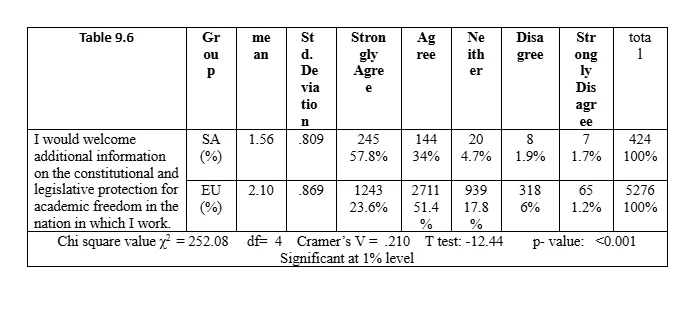
Table 9.6 gives information on whether participants’ would welcome additional information on the constitutional and legislative protection for academic freedom in the nation in which I work. It is found that comparison between groups is significantly different using chi square test (χ2 (4)= 252.08, p<0.001) with association coefficient (0.21) using Cramer’s V association measure. Disagree figure reaches about (3.8%) for Saudi Arabia group compared to (1.8%) for European Union group, while agreement level is (91.8%) for Saudi Arabia group compared to (75%) for European Union group, Moreover, there is (4.7%) neutral for Saudi Arabia group compared to much higher (17.8%) for European Union group. On the other hand, if the question is regarded as scale, the mean value for Saudi Arabia group (µ1=1.56) is higher than the mean value for European Union group (µ2=2.10) indicating a general higher agreement level for Saudi Arabia group.

Table 9.7 address whether respondents have an adequate working knowledge of the regulations, practices, and policies governing the protection for academic freedom within the institution in which I work. It is found that comparison between groups is not significantly different using chi square test (χ2 (4)= 19.69, p=.1180). Disagree figure reaches about (46.2%) for Saudi Arabia group compared to (46.8%) for European Union group, while agreement level is (25.6%) for Saudi Arabia group compared to (27.1%) for European Union group, Moreover, there is (27.9%) neutral for Saudi Arabia group compared to (26.1%) for European Union group. On the other hand, if the question is regarded as a scale, the mean value for Saudi Arabia group (µ1=3.35) is not much different than the mean value for European Union group (µ2=3.27) indicating no difference between the two groups regarding the mentioned statement.

Table 9.8 provides data on respondents’ they would welcome additional information on the regulations, practices, and policies governing the protection for academic freedom within the institution in which I work. It is found that comparison between groups is significantly different using chi square test (χ2 (4)= 228.06, p<0.001) with association coefficient (0.2) using Cramer’s V association measure. Disagree figure reaches about (3.3%) for Saudi Arabia group compared to (6.9%) for European Union group, while agreement level is (90.4%) for Saudi Arabia group compared to (75%) for European Union group, Moreover, there is (6.3%) neutral for Saudi Arabia group compared to much higher (17.4%) for European Union group. On the other hand, if the question is regarded as a scale, the mean value for Saudi Arabia group (µ1=1.56) is significantly lower than the mean value for European Union group (µ2=2.08) indicating a general higher agreement level for Saudi Arabia group.
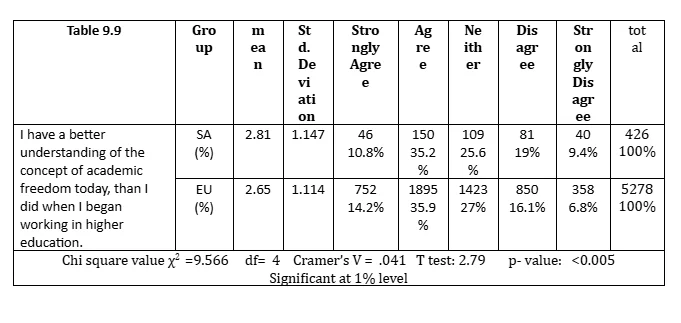
Table 9.9 gives information on whether staff have a better understanding of the concept of academic freedom today, than they did when they began working in higher education. It is found that comparison between groups is significantly different using chi square test (χ2 (4)= 9.566, p<0.005) with a very low association coefficient (0.041) using Cramer’s V association measure. Disagree figure reaches about (28.4%) for Saudi Arabia group compared to (22.9%) for European Union group, while agreement level is (46%) for Saudi Arabia group compared to (50.1%) for European Union group, Moreover, there is (25.6%) neutral for Saudi Arabia group compared to (27%) for European Union group. Indicating a general slightly higher disagreement level for Saudi Arabia group.
Question 12 was a composite question, which required respondents to utilize a five point scale (1= strongly agree and 5 = strongly disagree) to indicate the extent of their relative agreement/disagreement on "Institutional protection for academic freedom" with the following statements

Table 10.1 details respondents that participant gave about whether their higher education institution has provided them with an adequate introduction to the concept of academic freedom. It is found that comparison between groups is significantly different using chi square test (χ2 (4)= 27.23, p<0.001) with association coefficient (0.069) using Cramer’s V association measure. Disagree figure reaches about (4.5%) for Saudi Arabia group compared to (1.75%) for European Union group, while agreement level is (88.6%) for Saudi Arabia group compared to (86%) for European Union group, Moreover, there is (16.9%) neutral for Saudi Arabia group compared to (11.8%) for European Union group. On the other hand, if the question is regarded as scale the mean value for Saudi Arabia group (µ1=1.9) is higher than the mean value for European Union group (µ2=1.74) indicating a general slightly higher agreement level for European Union group.

Table 10.2 shows respondents answer about whether their higher education institution has provided them with an adequate introduction to the concept of academic freedom. It is found that comparison between groups is significantly different using chi square test (χ2 (4)= 93.05, p<0.001) with association coefficient (0.128) using Cramer’s V association measure. Disagree figure reaches about (13.8%) for Saudi Arabia group compared to (27%) for European Union group, while agreement level is (23.7%) for Saudi Arabia group compared to (32.5%) for European Union group, Moreover, there is (62.5%) neutral for Saudi Arabia group compared to (39.4%) for European Union group. On the other hand, if the question is regarded as scale, the mean value for Saudi Arabia group (µ1=2.85) is lower than the mean value for European Union group (µ2=2.92) but not significant using t-test (t(5)=-1.280, p=0.2).
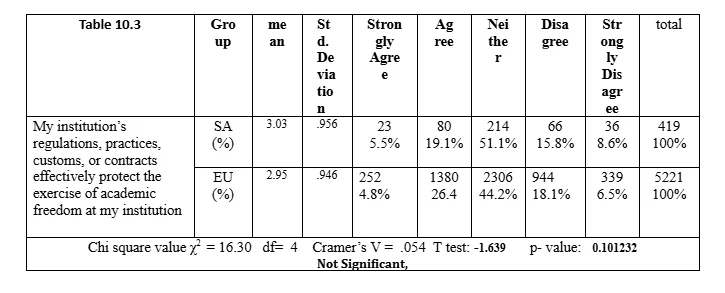
The results are shown in table 10.3 above, represents respondents to whether their institution’s regulations, practices, customs, or contracts effectively protect the exercise of academic freedom at their institution. There exist significant difference between the two groups among the 5-levels of agreement using chi square test (χ2 (4)= 16.3, p<0.001) with a small association coefficient (0.054) using Cramer’s V association measure Disagree figure is about (24.4%) for Saudi Arabia group compared to (24.6%) for European Union group, while agreement level reaches (24.6%) for Saudi Arabia group compared to (30.2%) for European Union group, Moreover, there exist the highest portion as neutral (51.1%) neutral for Saudi Arabia group compared to (44.2%) for European Union group. On the other hand, if the question is regarded as a scale, the mean value for Saudi Arabia group (µ1=3.03) have no significant difference compared to European Union group (µ2=2.95) using t-test (t(5638)=-1.280, p=0.2).

Table 10.4 address whether respondents think that their institution should have the right to revoke an invitation to an outside speaker because of the “controversial” content of the speaker’s prior speeches. It is found that comparison between groups is significantly different using chi square test (χ2 (4)= 177, p<0.001) with association coefficient (0.177) using Cramer’s V association measure. Disagree figure reaches about (20%) for Saudi Arabia group compared to much higher (51.5%) for European Union group, while agreement level is (42.6%) for Saudi Arabia group compared to (22.1%) for European Union group, Moreover, there is (37.4%) neutral for Saudi Arabia group compared to (26.5%) for European Union group. On the other hand, if the question is regarded as a scale, the mean value for Saudi Arabia group for Saudi Arabia group (µ1=2.71) is lower than the mean value for European Union group (µ2=3.44) indicating a general higher agreement level for Saudi Arabia group.

Table 10.5 shows respondents answers about whether their issues related to academic freedom at their institution are being discussed or addressed more frequently now, than they were when they first started their employment here. It is found that comparison between groups is significantly different using chi square test (χ2 (4)= 27.58, p=0.0016) with association coefficient (0.070) using Cramer’s V association measure. Disagree figure reaches about (28.2%) for Saudi Arabia group compared to (39.5%) for European Union group, while agreement level is (23.5%) for Saudi Arabia group compared to (19.6%) for European Union group, Moreover, there is (48%) neutral for Saudi Arabia group compared to (40.9%) for European Union group. On the other hand, if the question is regarded as a scale, the mean value for Saudi Arabia group (µ1=3.13) is lower than the mean value for European Union group (µ2=3.29) indicating a small difference for general higher disagreement level European Union group.

Table 10.6 details participants’ respondents about whether it is important that complaints by staff regarding academic freedom violations can be directed to an institutional and/or departmental/faculty grievance body. It is found that comparison between groups is significantly different using chi square test (χ2 (4)= 53.6, p<0.001) with association coefficient (0.097) using Cramer’s V association measure. Disagree figure reaches about (5%) for Saudi Arabia group compared to (2.1%) for European Union group, while agreement level is (76%) for Saudi Arabia group compared to (87.9%) for European Union group, Moreover, there is (19%) neutral for Saudi Arabia group compared to (9.9%) for European Union group. On the other hand, if the question is regarded as a scale, the mean value for Saudi Arabia group (µ1=1.94) is higher than the mean value for European Union group (µ2=1.77) indicating a general slightly higher agreement level for European Union group.
Question 13 "Your opinions on higher education and academic freedom in your institution"
In this section various respondents were asked to give their personal opinion regarding the following statements in respect to academic freedom from their institution:
An academic’s first loyalty should be to research in his/her discipline.
An academic’s first loyalty should be to the teaching of students.
The "unity of research and teaching" is an ideal that should be upheld for higher education institutions and academic staff.
An academic’s first loyalty should be to his/her department, rather than the higher education institution.
My higher education institution assesses staff performance too often and places insufficient trust in my competences as a good teacher and researcher.
In my higher education institution, assessment of performance is too dependent on devotion to teaching.
In my higher education institution, assessment of performance is too dependent on students’ formal evaluations of their teachers.
In my higher education institution, assessment of performance is too dependent on the extent to which academic staff have been able to acquire research funding. My higher education institution places such a teaching load on me that this leaves insufficient time to carry out proper research.
In my nation, there is too much emphasis on providing higher education for as many students as possible at the expense of providing higher education of a higher quality to a smaller group of only "capable" students
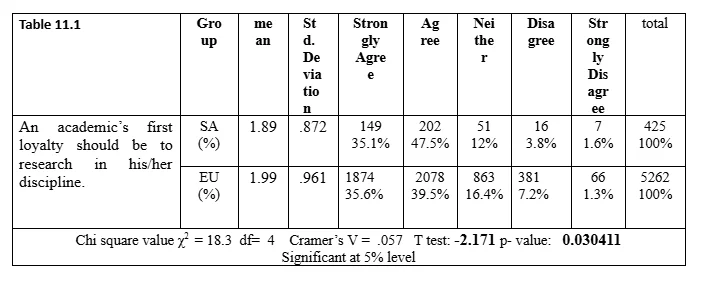
Table 11.1 provides data on respondents’ an academic’s first loyalty should be to research in his/her discipline.’ There exist significant difference between the two groups among the 5-levels of agreement using chi square test (χ2 (4)= 16.3, p<0.001) with a small association coefficient (0.057) using Cramer’s V association measure. Disagreement level is about (5.4%) for Saudi Arabia group compared to (8.5%) for European Union group, while agreement level is (82.6%) for Saudi Arabia group compared to (75.1%) for European Union group, Moreover, there exist about (12%) as neutral for Saudi Arabia group compared to (16.4%) for European Union group. On the other hand, if the question is looked at as scale, the mean value for Saudi Arabia group (µ1=1.89) have significant difference compared to European Union group (µ2=1.99) using t-test at 5% significance level (t(5685)= -2.171, p=0.03).

Table 11.2 gives information on whether an academic’s first loyalty should be to the teaching of students. There exist a significant difference between the two groups among the 5-levels of agreement using chi square test (χ2 (4)= 42.3 , p<0.001) with a small association coefficient (0.086) using Cramer’s V association measure. Disagreement level is about (7.4%) for Saudi Arabia group compared to (9.1%) for European Union group, while agreement level is (77.4%) for Saudi Arabia group compared to (69.2%) for European Union group, Moreover, there exist about (15.1%) as neutral for Saudi Arabia group compared to (21.8%) for European Union group. On the other hand, if the question is looked at as scale, the mean value for Saudi Arabia group (µ1=1.91) is lower than European Union group (µ2=2.13) and have a significant difference using t-test at 1% significance level (t(5675)= -4.699, p<0.001). looking at results from table 11.1 and table 11.2 we can see that academics from both Saudi Arabia and European Union believed that academics first loyalty should be to research in his/her discipline, that might be due to the less opportonies for saudi to focos on their research

Table 11.3 addresses whether respondents believed that, The "unity of research and teaching" is an ideal that should be upheld for higher education institutions and academic staff. There exist a significant difference between the two groups among the 5-levels of agreement using chi square test (χ2 (4)= 61.9 , p<0.001) with a small association coefficient (0.105) using Cramer’s V association measure. Disagreement level is about (1.4%) for Saudi Arabia group compared to (4.7%) for European Union group, while agreement level is (94.6%) for Saudi Arabia group compared to (84.7%) for European Union group, Moreover, there exist about (4%) as neutral for Saudi Arabia group compared to (10.6%) for European Union group. On the other hand, if the question is looked at as scale, the mean value for Saudi Arabia group (µ1=1.42) is lower than European Union group (µ2=1.74) and have a significant difference using t-test at 1% significance level (t(5672)= -9.381, p<0.001) indicating higher general agreement level for Saudi Arabia group.
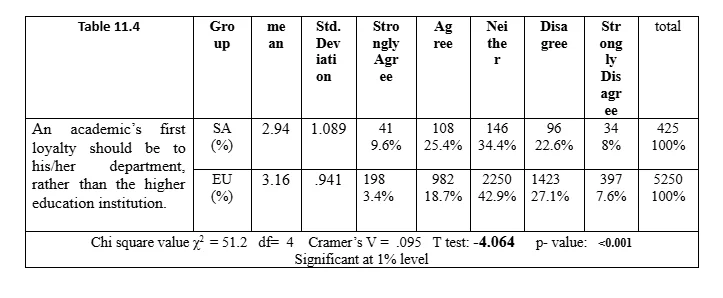
Table 11.4 provides information when asking respondents whether an academic’s first loyalty should be to his/her department, rather than the higher education institution. There exist a significant difference between the two groups among the 5-levels of agreement using chi square test (χ2 (4)= 51.2 , p<0.001) with a small association coefficient (0.095) using Cramer’s V association measure. Disagreement level is about (31.6%) for Saudi Arabia group compared to (34.7%) for European Union group, while agreement level is (35%) for Saudi Arabia group compared to (22.1%) for European Union group, Moreover, there exist about (34.4%) as neutral for Saudi Arabia group compared to (42.9%) for European Union group. On the other hand, if the question is looked at as scale, the mean value for Saudi Arabia group (µ1=2.94) is lower than European Union group (µ2=3.16) and have a significant difference using t-test at 1% significance level (t(5673)= -4.064, p<0.001) indicating higher general agreement level for Saudi Arabia group.

Results in table 11.5 above provide information when asking respondents whether their higher education institution assesses staff performance too often and places insufficient trust in my competences as a good teacher and researcher. There exist a significant difference between the two groups among the 5-levels of agreement using chi square test (χ2 (4)= 81.3 , p<0.001) with association coefficient (0.120) using Cramer’s V association measure. Disagreement level is about (22.4%) for Saudi Arabia group compared to (42.1%) for European Union group, while agreement level is (34.6%) for Saudi Arabia group compared to (29.7%) for European Union group, Moreover, there exist about (43%) as neutral for Saudi Arabia group compared to (28.2%) for European Union group. On the other hand, if the question is looked at as scale, the mean value for Saudi Arabia group (µ1=2.85) is lower than European Union group (µ2=3.11) and have a significant difference using t-test at 1% significance level (t(5669)= -4.937, p<0.001) indicating higher general agreement level for Saudi Arabia group.

Results in table 11.6 above provide information when asking respondents “In my higher education institution, assessment of performance is too dependent on the number of (shorter) publications (at the expense of better quality and/or monograph publication).” There exist a significant difference between the two groups among the 5-levels of agreement using chi square test (χ2 (4)= 90.3 , p<0.001) with association coefficient (0.126) using Cramer’s V association measure. Disagreement level is about (17.7%) for Saudi Arabia group compared to (20/9%) for European Union group, while agreement level is (40.3%) for Saudi Arabia group compared to (55.9%) for European Union group, Moreover, there exist about (42%) as neutral for Saudi Arabia group compared to (23.1%) for European Union group. On the other hand, if the question is looked at as scale, the mean value for Saudi Arabia group (µ1=2.72) is higher than European Union group (µ2=2.46) and have a significant difference using t-test at 1% significance level (t(5673)= 5.167, p<0.001) indicating higher general agreement level for Saudi Arabia group. The percenatge of respondent in Saudi Arabia who are nither agree or dissagree, reflects a high level of ignorance between academics , so how they would have a fair assessment to their performance and they have no idea about the criteria.

The results in table 11.7 above show respondents answer on whether their higher education institution, assessment of performance is too dependent on devotion to teaching. There exist a significant difference between the two groups among the 5-levels of agreement using chi square test (χ2 (4)= 249, p<0.001) with association coefficient (0.210) using Cramer’s V association measure. Disagreement level is about (30.1%) for Saudi Arabia group compared to (43.2%) for European Union group, while agreement level is (58.3%) for Saudi Arabia group compared to (14.9%) for European Union group, Moreover, there exist about (26.6%) as neutral for Saudi Arabia group compared to (26.8%) for European Union group. On the other hand, if the question is looked at as scale, the mean value for Saudi Arabia group (µ1=2.88) is lower than European Union group (µ2=3.56) and have a significant difference using t-test at 1% significance level (t(5660)= 12.174, p<0.001) indicating higher general agreement level for Saudi Arabia group.
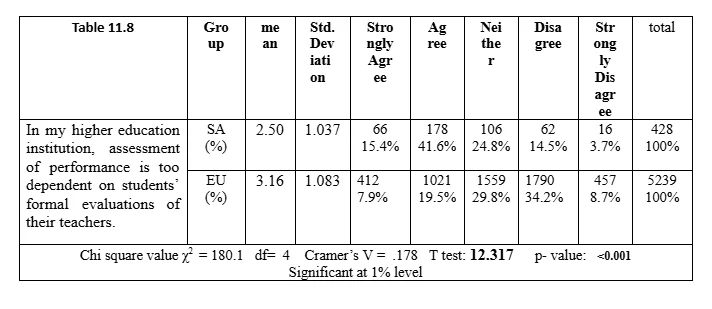
Table 11.8 shows respondents’ reflects on whether In their higher education institution, assessment of performance is too dependent on students’ formal evaluations of their teachers. There exist a significant difference between the two groups among the 5-levels of agreement using chi square test (χ2 (4)= 180.1, p<0.001) with association coefficient (0.178) using Cramer’s V association measure. Disagreement level is about (18.2%) for Saudi Arabia group compared to (42.9%) for European Union group, while agreement level is (57%) for Saudi Arabia group compared to (27.4%) for European Union group, Moreover, there exist about (24.8%) as neutral for Saudi Arabia group compared to (29.8%) for European Union group. On the other hand, if the question is looked at as scale, the mean value for Saudi Arabia group (µ1=2.5) is lower than European Union group (µ2=3.16) and have a significant difference using t-test at 1% significance level (t(5665)= 12.317, p<0.001) indicating higher general agreement level for Saudi Arabia group.
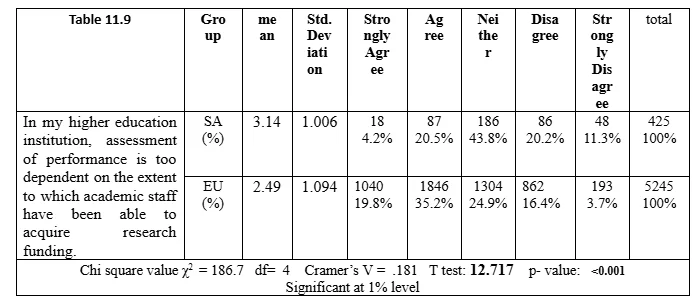
Table 11.9 provide participant responses to whether In their higher education institution, assessment of performance is too dependent on the extent to which academic staff have been able to acquire research funding.. There exist a significant difference between the two groups among the 5-levels of agreement using chi square test (χ2 (4)= 186.7, p<0.001) with association coefficient (0.181) using Cramer’s V association measure. Disagreement level is about (31.52%) for Saudi Arabia group compared to (20.1%) for European Union group, while agreement level is (24.7%) for Saudi Arabia group compared to (55%) for European Union group, Moreover, there exist about (43.8%) as neutral for Saudi Arabia group compared to (24.9%) for European Union group. On the other hand, if the question is looked at as scale, the mean value for Saudi Arabia group (µ1=3.14) is higher than European Union group (µ2=2.49) and have a significant difference using t-test at 1% significance level (t(5668)= 12.717, p<0.001) indicating higher general agreement level for European Union.

Table 11.10 details respondents that participants give to the statements ‘my higher education institution places such a teaching load on me that this leaves insufficient time to carry out proper research.’ There exist a significant difference between the two groups among the 5-levels of agreement using chi square test (χ2 (4)= 104.9, p<0.001) with association coefficient (0.136) using Cramer’s V association measure. Disagreement level is about (16.9%) for Saudi Arabia group compared to (32.3%) for European Union group, while agreement level is (67.1%) for Saudi Arabia group compared to (43.3%) for European Union group, Moreover, there exist about (16%) as neutral for Saudi Arabia group compared to (24.3%) for European Union group. On the other hand, if the question is looked at as scale, the mean value for Saudi Arabia group (µ1=2.19) is lower than European Union group (µ2=2.8) and have a significant difference using t-test at 1% significance level (t(5658)= 10.535, p<0.001) indicating higher general agreement level for Saudi Arabia group.

Table 11.11 details respondents to the statement ‘My higher education institution places too many administrative duties(preparing budget plans, internal audits, seeking funding etc.) on me that this leaves insufficient time to carry out proper research.’ There is no exist for a significant difference between the two groups among the 5-levels of agreement using chi square test (χ2 (4)= 7.9, p>0.05). Disagreement level is about (17.4%) for Saudi Arabia group compared to (22.2%) for European Union group, while agreement level is (63.6%) for Saudi Arabia group compared to (59.1%) for European Union group, Moreover, there exist about (19%) as neutral for Saudi Arabia group compared to (18.6%) for European Union group. On the other hand, if the question is looked at as scale, the mean value for Saudi Arabia group (µ1=2.27) is lower than European Union group (µ2=2.42) and have a significant difference using t-test at 1% significance level (t(5677)= -2.560, p<0.001) indicating higher general agreement level for Saudi Arabia group.

Table 11.12 address whether there should be specific legal protection for academic freedom, beyond that existing for free speech. There exist a significant difference between the two groups among the 5-levels of agreement using chi square test (χ2 (4)= 43.4, p<0.001) with association coefficient (0.088) using Cramer’s V association measure. Disagreement level is about (2.6%) for Saudi Arabia group compared to (5.90%) for European Union group, while agreement level is (78.7%) for Saudi Arabia group compared to (68.7 %) for European Union group, Moreover, there exist about (19%) as neutral for Saudi Arabia group compared to (25.4%) for European Union group. On the other hand, if the question is looked at as scale, the mean value for Saudi Arabia group (µ1=1.82) is lower than European Union group (µ2=2.1) and have a significant difference using t-test at 1% significance level (t(5670)= -6.175, p<0.001) indicating higher general agreement level for Saudi Arabia group.

Table 11.13 provide information on respondents to whether Academic freedom also covers comments by teachers/researchers beyond the narrow confines of their specific field of specialization, to cover broader political, economic, social and cultural issues on which their teaching/research has an impact. There exist a significant difference between the two groups among the 5-levels of agreement using chi square test (χ2 (4)=38.5, p<0.001) with association coefficient (0.083) using Cramer’s V association measure. Disagreement level is about (9.2%) for Saudi Arabia group compared to (6.80%) for European Union group, while agreement level is (57.5%) for Saudi Arabia group compared to (69.3%) for European Union group, Moreover, there exist about (33%) as neutral for Saudi Arabia group compared to (23.1%) for European Union group. On the other hand, if the question is looked at as scale, the mean value for Saudi Arabia group (µ1=2.32) is slightly higher than European Union group (µ2=2.12) and have a significant difference using t-test at 1% significance level (t(5643)= 3.971, p<0.001) indicating higher general agreement level for European Union group.

Table 11.14 shows participants’ respondents to whether Higher education does not put enough emphasis on vocational training, and the need for students to get a job There exist a significant difference between the two groups among the 5-levels of agreement using chi square test (χ2 (4)= 204.9, p<0.001) with association coefficient (0.190) using Cramer’s V association measure. Disagreement level is about (10.5%) for Saudi Arabia group compared to (30.70%) for European Union group, while agreement level is (64.6%) for Saudi Arabia group compared to (36.3%) for European Union group, Moreover, there exist about (25%) as neutral for Saudi Arabia group compared to (33.1%) for European Union group. On the other hand, if the question is looked at as scale, the mean value for Saudi Arabia group (µ1=2.21) is lower than European Union group (µ2=2.92) and have a significant difference using t-test at 1% significance level (t(5667)= 13.471, p<0.001) indicating higher general agreement level for Saudi Arabia group

Table 11.1 shows respondents answers on whether the rector/vice chancellor should come from within the institution, and academic staff should be able to exercise decisive control over his/her nomination, election and appointment. There exist a significant difference between the two groups among the 5-levels of agreement using chi square test (χ2 (4)=52.3, p<0.001) with association coefficient (0.096) using Cramer’s V association measure. Disagreement level is about (5.3%) for Saudi Arabia group compared to (10.6%) for European Union group, while agreement level is (81.5%) for Saudi Arabia group compared to (67.4%) for European Union group, Moreover, there exist about (13%) as neutral for Saudi Arabia group compared to (21.9%) for European Union group. On the other hand, if the question is looked at as scale, the mean value for Saudi Arabia group (µ1=1.8) is lower than European Union group (µ2=2.14) and have a significant difference using t-test at 1% significance level (t(5652)= -7.148, p<0.001) indicating higher general agreement level for Saudi Arabia group.
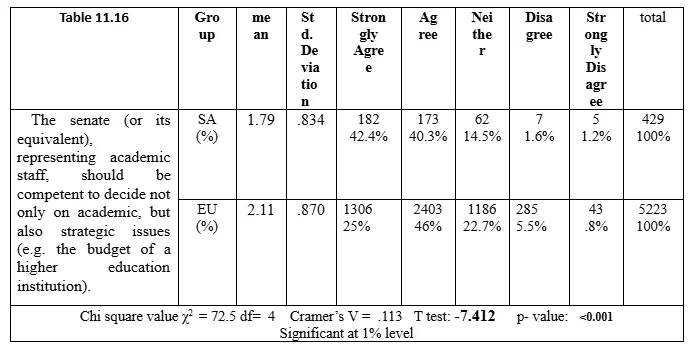
Results in table 11.16 above provide information when asking respondents whether the senate (or its equivalent), representing academic staff, should be competent to decide not only on academic, but also strategic issues (e.g. the budget of a higher education institution). There exist a significant difference between the two groups among the 5-levels of agreement using chi square test (χ2 (4)=72.5, p<0.001) with association coefficient (0.113) using Cramer’s V association measure. Disagreement level is about (2.8%) for Saudi Arabia group compared to (6.3%) for European Union group, while agreement level is (82.7%) for Saudi Arabia group compared to (71%) for European Union group, Moreover, there exist about (15%) as neutral for Saudi Arabia group compared to (22.7%) for European Union group. On the other hand, if the question is looked at as scale, the mean value for Saudi Arabia group (µ1=1.79) is lower than European Union group (µ2=2.11) and have a significant difference using t-test at 1% significance level (t(5650)= -7.412, p<0.001) indicating higher general agreement level for Saudi Arabia group.

Table 11.17 provides information when asking respondents whether Higher education institutions should, apart from the senate (or its equivalent), have a board composed of a majority of external experts, competent to decide/confirm decisions on strategic issues (e.g. the budget of a higher education institution). There exist a significant difference between the two groups among the 5-levels of agreement using chi square test (χ2 (4)=466.1, p<0.001) with association coefficient (0.288) using Cramer’s V association measure. Disagreement level is about (6.8%) for Saudi Arabia group compared to (33.6%) for European Union group, while agreement level is (74.7%) for Saudi Arabia group compared to (33.1%) for European Union group, Moreover, there exist about (19%) as neutral for Saudi Arabia group compared to (33.3%) for European Union group. On the other hand, if the question is looked at as scale, the mean value for Saudi Arabia group (µ1=1.99) is lower than European Union group (µ2=3.02) and have a significant difference using t-test at 1% significance level (t(5634)= 21.582, p<0.001) indicating higher agreement level for Saudi Arabia group.

Table 11.18 address whether respondents believe that the dean/head of department should come from within the faculty/department, and academic staff should be able to exercise decisive control over his/her nomination, election and appointment. There exist a significant difference between the two groups among the 5-levels of agreement using chi square test (χ2 (4)=69.1, p<0.001) with association coefficient (0.111) using Cramer’s V association measure. Disagreement level is about (2.1%) for Saudi Arabia group compared to (8%) for European Union group, while agreement level is very high (90.6%) for Saudi Arabia group compared to (75.5%) for European Union group, Moreover, there exist about (7%) as neutral for Saudi Arabia group compared to (16.5%) for European Union group. On the other hand, if the question is looked at as scale, the mean value for Saudi Arabia group (µ1=1.6) is lower than European Union group (µ2=1.99) and have a significant difference using t-test at 1% significance level (t(5655)=10.410, p<0.001) indicating higher agreement level for Saudi Arabia group.

Table 11.19 gives information on whether staff thinks that there should be fewer representatives from industry and business on the governing bodies of public higher education institutions. There exist a significant difference between the two groups among the 5-levels of agreement using chi square test (χ2 (4)=50.8, p<0.001) with association coefficient (0.095) using Cramer’s V association measure. Disagreement level is about (8.6%) for Saudi Arabia group compared to (16.2%) for European Union group, while agreement level is very high (67.5%) for Saudi Arabia group compared to (50.1%) for European Union group, Moreover, there exist about (24%) as neutral for Saudi Arabia group compared to (33.7%) for European Union group. On the other hand, if the question is looked at as scale, the mean value for Saudi Arabia group (µ1=2.13) is lower than European Union group (µ2=2.48) and have a significant difference using t-test at 1% significance level (t(5657)=-7.041, p<0.001) indicating higher agreement level for Saudi Arabia group

Table 11.20 shows results given by staff on statement ‘ The marketing of their products and services (fees for foreign students, "selling" intellectual property rights, performing research commissioned by private industry, etc.) should constitute a central activity of public higher education institutions.’ There exist a significant difference between the two groups among the 5-levels of agreement using chi square test (χ2 (4)= 1110.8, p<0.001) with association coefficient (0.444) using Cramer’s V association measure. Disagreement level is about (4.9%) for Saudi Arabia group compared to (57.5%) for European Union group, while agreement level is (73.1%) for Saudi Arabia group compared to (14.3%) for European Union group, Moreover, there exist about (22%) as neutral for Saudi Arabia group compared to (28.1%) for European Union group. On the other hand, if the question is looked at as scale, the mean value for Saudi Arabia group (µ1=2.05) is lower than European Union group (µ2=3.63) and have a significant difference using t-test at 1% significance level (t(5641)= 34.748, p<0.001) indicating higher general agreement level for Saudi Arabia group.

Table 11.21 shows respondents to the statement ‘Public higher education institutions should be obliged to openly reveal all commissioned research projects once completed and clearly identify the sources of funding.’ There is no exist to a significant difference between the two groups among the 5-levels of agreement using chi square test (χ2 (4)= 2.076, p>0.05) and hence Cramer’s V is meaningless. Disagreement level is about (2.1%) for Saudi Arabia group compared to (3%) for European Union group, while agreement level is (85.3%) for Saudi Arabia group compared to (85.5%) for European Union group, Moreover, there exist about (12.5%) as neutral for Saudi Arabia group compared to (11.5%) for European Union group. On the other hand,there is no significant difference between the mean value for Saudi Arabia group and European union group with 1.77 and 1.79 respectively. The t-test is used as a significance test as (t(5629)=-0.385 , p=0.7) impling that there is no difference between the two means.
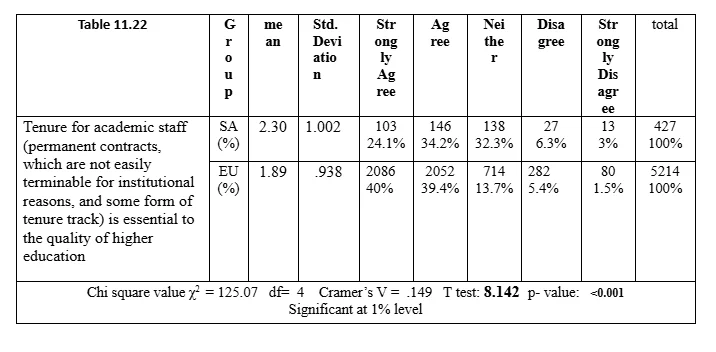
Looking at table 11.22 we can see staff respondents to whether Tenure for academic staff (permanent contracts, which are not easily terminable for institutional reasons, and some form of tenure track) is essential to the quality of higher education. There exist a significant difference between the two groups among the 5-levels of agreement using chi square test (χ2 (4)= 125.07, p<0.001) with association coefficient (0.149) using Cramer’s V association measure. Disagreement level is about (9.3%) for Saudi Arabia group compared to (6.9%) for European Union group, while agreement level is (58.3%) for Saudi Arabia group compared to (79.4%) for European Union group, Moreover, there exist about (32.3%) as neutral for Saudi Arabia group compared to (13.7%) for European Union group. On the other hand, if the question is looked at as scale, the mean value for Saudi Arabia group (µ1=2.30) is greater than European Union group (µ2=1.89) and have a significant difference using t-test at 1% significance level (t(5639)= 8.142, p<0.001) indicating higher general agreement level for European Union group.

Table 11.23 shows results given by staff on statement ‘Tenure for academic staff (permanent contracts, which are not easily terminable for institutional reasons, and some form of tenure track) is essential to maintain academic freedom. There exist a significant difference between the two groups among the 5-levels of agreement using chi square test (χ2 (4)= 75.6, p<0.001) with association coefficient (0.116) using Cramer’s V association measure. Disagreement level is about (8.5%) for Saudi Arabia group compared to (7.6%) for European Union group, while agreement level is (61.6%) for Saudi Arabia group compared to (77%) for European Union group, Moreover, there exist about (29.9%) as neutral for Saudi Arabia group compared to (15.4%) for European Union group. On the other hand, if the question is looked at as scale, the mean value for Saudi Arabia group (µ1=2.24) is greater than European Union group (µ2=1.91) and have a significant difference using t-test at 1% significance level (t(5653)= 6.663, p<0.001) indicating higher general agreement level for European Union group

Table 11.24 shows respondents to the statement ‘Research funding is much more effective if it is concentrated in the hands of a few elite higher education institutions.’ There exist a significant difference between the two groups among the 5-levels of agreement using chi square test (χ2 (4)= 643.9, p<0.001) with association coefficient (0.338) using Cramer’s V association measure. Disagreement level is about (23.6%) for Saudi Arabia group compared to (69.4%) for European Union group, while agreement level is (49.3%) for Saudi Arabia group compared to (10.7%) for European Union group, Moreover, there exist about (27.1%) as neutral for Saudi Arabia group compared to (19.9%) for European Union group. On the other hand, if the question is looked at as scale, the mean value for Saudi Arabia group (µ1=2.62) is less than European Union group (µ2=3.9) and have a significant difference using t-test at 1% significance level (t(5651)= 22.033, p<0.001) indicating higher general agreement level for Saudi Arabia group

Table 11.25 shows results given by staff on statement ‘The system of having to apply for research funding for particular projects (through research councils/foundations etc.) prevents me from selecting the research topics “my academic instinct tells me” are the topics on which research should focus.’ There exist a significant difference between the two groups among the 5-levels of agreement using chi square test (χ2 (4)= 20.4, p<0.001) with Cramer’s V association coefficient equals 0.06. Disagreement level is about (10.3%) for Saudi Arabia group compared to (18.4%) for European Union group, while agreement level is (56.6%) for Saudi Arabia group compared to (54.6%) for European Union group, Moreover, there exist about (33.2%) as neutral for Saudi Arabia group compared to (27%) for European Union group. On the other hand,there is no significant difference between the mean value for Saudi Arabia group and European union group with 2.37 and 1.48 respectively. The t-test is used as a significance test as (t(5642)=-2.293 , p=0.0.3) impling that there is no difference between the two means at 1% level.

Table 11.26 shows respondents answers on whether The system of research funding described in the previous question prompts a focus on research yielding short-term results of social benefit at the expense of research promoting long-term knowledge (elementary research). There exist a significant difference between the two groups among the 5-levels of agreement using chi square test (χ2 (4)= 80.4, p<0.001) with association coefficient (0.120) using Cramer’s V association measure. Disagreement level is about (9.3%) for Saudi Arabia group compared to (9.9%) for European Union group, while agreement level is (49.2%) for Saudi Arabia group compared to (66.9%) for European Union group, Moreover, there exist about (41.5%) as neutral for Saudi Arabia group compared to (23.3%) for European Union group. On the other hand, if the question is looked at as scale, the mean value for Saudi Arabia group (µ1=2.47) is greater than European Union group (µ2=2.17) and have a significant difference using t-test at 1% significance level (t(5631)= 6.235, p<0.001) indicating higher general agreement level for European Union group.

Results in table 11.27 above provide information when asking respondents whether the stated system of research funding often allows insufficient time to properly complete research on a topic. There exist a significant difference between the two groups among the 5-levels of agreement using chi square test (χ2 (4)= 90.54, p<0.001) with association coefficient (0.127) using Cramer’s V association measure. Disagreement level is about (6.1%) for Saudi Arabia group compared to (8.9%) for European Union group, while agreement level is (52.4%) for Saudi Arabia group compared to (68.4%) for European Union group, Moreover, there exist about (41.5%) as neutral for Saudi Arabia group compared to (22.7%) for European Union group. On the other hand, if the question is looked at as scale, the mean value for Saudi Arabia group (µ1=2.42) is greater than European Union group (µ2=2.16) and have a significant difference using t-test at 1% significance level (t(5639)= 5.698, p<0.001) indicating higher general agreement level for European Union group.

Table 11.28 shows respondents to the statement ‘my higher education institution places too much emphasis on collaborative research, leaving insufficient time for individual research.’ There exist a significant difference between the two groups among the 5-levels of agreement using chi square test (χ2 (4)= 37.6, p<0.001) with association coefficient (0.082) using Cramer’s V association measure. Disagreement level is about (22.7%) for Saudi Arabia group compared to (37.1%) for European Union group, while agreement level is (32.4%) for Saudi Arabia group compared to (27.4%) for European Union group, Moreover, there exist about (44.9%) as neutral for Saudi Arabia group compared to (35.5%) for European Union group. On the other hand, if the question is looked at as scale, the mean value for Saudi Arabia group (µ1=2.86) is less than European Union group (µ2=3.08) and have a significant difference using t-test at 1% significance level (t(5641)= -4.414, p<0.001) indicating higher general agreement level for Saudi Arabia group.
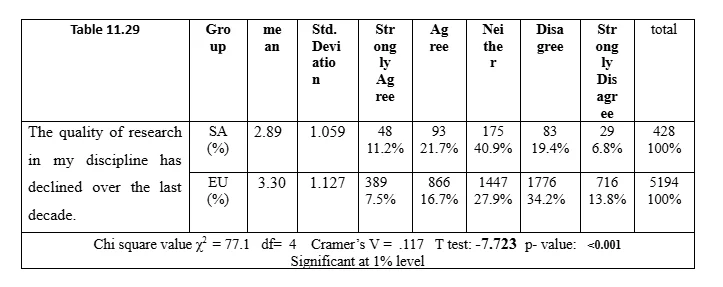
Table 11.29 shows respondents answers on whether the quality of research in their discipline has declined over the last decade. There exist a significant difference between the two groups among the 5-levels of agreement using chi square test (χ2 (4)= 77.1, p<0.001) with association coefficient (0.117) using Cramer’s V association measure. Disagreement level is about (26.2%) `for Saudi Arabia group compared to (48%) for European Union group, while agreement level is (32.9%) for Saudi Arabia group compared to (24.2%) for European Union group, Moreover, there exist about (40.9%) as neutral for Saudi Arabia group compared to (27.9%) for European Union group. On the other hand, if the question is looked at as scale, the mean value for Saudi Arabia group (µ1=2.89) is less than European Union group (µ2=3.30) and have a significant difference using t-test at 1% significance level (t(5620)= -7.723, p<0.001) indicating higher general agreement level for Saudi Arabia group.

Looking at table 11.30 we can see staff respondents to whether the quality of teaching in their discipline has declined over the last decade. There exist a significant difference between the two groups among the 5-levels of agreement using chi square test (χ2 (4)= 77.1, p<0.001) with association coefficient (0.117) using Cramer’s V association measure. Disagreement level is about (26.2%) for Saudi Arabia group compared to (48%) for European Union group, while agreement level is (32.9%) for Saudi Arabia group compared to (24.2%) for European Union group, Moreover, there exist about (40.9%) as neutral for Saudi Arabia group compared to (27.9%) for European Union group. On the other hand, if the question is looked at as scale, the mean value for Saudi Arabia group (µ1=2.89) is less than European Union group (µ2=3.30) and have a significant difference using t-test at 1% significance level (t(5603)= -7.723, p<0.001) indicating higher general agreement level for Saudi Arabia group.

Table 11.31 shows results given by staff on statement ‘In their higher education institution, the desire to obtain a good position in higher education institution rankings has compromised the freedom to teach and/or to carry out research.’ There exist a significant difference between the two groups among the 5-levels of agreement using chi square test (χ2 (4)= 64.7, p<0.001) with association coefficient (0.107) using Cramer’s V association measure. Disagreement level is about (13.3%) for Saudi Arabia group compared to (28.4%) for European Union group, while agreement level is (55.3%) for Saudi Arabia group compared to (37.9%) for European Union group, Moreover, there exist about (31.3%) as neutral for Saudi Arabia group compared to (33.7%) for European Union group. On the other hand, if the question is looked at as scale, the mean value for Saudi Arabia group (µ1=2.42) is less than European Union group (µ2=2.84) and have a significant difference using t-test at 1% significance level (t(5628)= -7.642, p<0.001) indicating higher general agreement level for Saudi Arabia group.

Table 11.32 shows respondents to the statement ‘in my nation, there is too much emphasis on providing higher education for as many students as possible at the expense of providing higher education of a higher quality to a smaller group of only "capable" students.’ There exist a significant difference between the two groups among the 5-levels of agreement using chi square test (χ2 (4)= 23.1, p<0.001) with association coefficient (0.64) using Cramer’s V association measure. Disagreement level is about (12.1%) for Saudi Arabia group compared to (21.9%) for European Union group, while agreement level is (64%) for Saudi Arabia group compared to (57.5%) for European Union group, Moreover, there exist about (23.8%) as neutral for Saudi Arabia group compared to (20.4%) for European Union group. On the other hand, if the question is looked at as scale, the mean value for Saudi Arabia group (µ1=2.23) is less than European Union group (µ2=2.45) and have a significant difference using t-test at 1% significance level (t(5641)= -4.213, p<0.001) indicating higher general agreement level for Saudi Arabia group.

Table 11.33 shows respondents to the statement ‘ In my nation, public respect for academic staff in higher education institutions has declined over the last decade.’ There exist a significant difference between the two groups among the 5-levels of agreement using chi square test (χ2 (4)= 33.6, p<0.001) with association coefficient (0.77) using Cramer’s V association measure. Disagreement level is about (19.8%) for Saudi Arabia group compared to (14.1%) for European Union group, while agreement level is (61%) for Saudi Arabia group compared to (63.9%) for European Union group, Moreover, there exist about (19.3%) as neutral for Saudi Arabia group compared to (22%) for European Union group. On the other hand, there is no significant difference between the mean value for Saudi Arabia group and European union group with 2.34 and 2.27 respectively. The t-test is used as a significance test as (t(5641)=1.259 , p=0.0.1) impling that there is no difference between the two means.

Table 11.34 address whether respondents believe that in their nation, academic salaries have declined so much in the last decade that they are too low to attract and retain high quality staff. There exist a significant difference between the two groups among the 5-levels of agreement using chi square test (χ2 (4)= 15.7, p<0.001) with association coefficient (0.053) using Cramer’s V association measure. Disagreement level is about (19%) for Saudi Arabia group compared to (21.3%) for European Union group, while agreement level is (60.9%) for Saudi Arabia group compared to (54.1%) for European Union group, Moreover, there exist about (20.1%) as neutral for Saudi Arabia group compared to (24.6%) for European Union group. On the other hand, there is no significant difference between the mean value for Saudi Arabia group and European union group with 2.29 and 2.46 respectively. The t-test is used as a significance test as (t(5645)=-2.915 , p=0.0.003) impling that there is no difference between the two means at 1% significance level.

Looking at table 11.35 we can see staff respondents to whether public higher education institutions should not be too dependent on the government for funding. There exist a significant difference between the two groups among the 5-levels of agreement using chi square test (χ2 (4)= 439.9, p<0.001) with association coefficient (0.28) using Cramer’s V association measure. Disagreement level is about (6.6%) for Saudi Arabia group compared to (39%) for European Union group, while agreement level is (78.1%) for Saudi Arabia group compared to (34.3%) for European Union group, Moreover, there exist about (15.3%) as neutral for Saudi Arabia group compared to (26.8%) for European Union group. On the other hand, if the question is looked at as scale, the mean value for Saudi Arabia group (µ1=1.88) is less than European Union group (µ2=3.04) and have a significant difference using t-test at 1% significance level (t(5625)= 23.869, p<0.001) indicating higher general agreement level for Saudi Arabia group.

Results in table 11.36 above provide information when asking respondents whether Public higher education institutions Public higher education institutions should be less under the control of the government. There exist a significant difference between the two groups among the 5-levels of agreement using chi square test (χ2 (4)= 57.2, p<0.001) with association coefficient (0.101) using Cramer’s V association measure. Disagreement level is about (13.8%) for Saudi Arabia group compared to (15.4%) for European Union group, while agreement level is (64.5%) for Saudi Arabia group compared to (53.9%) for European Union group, Moreover, there exist about (21.7%) as neutral for Saudi Arabia group compared to (30.9%) for European Union group. On the other hand, if the question is looked at as scale, the mean value for Saudi Arabia group (µ1=2.20) is less than European Union group (µ2=2.44) and have a significant difference using t-test at 1% significance level (t(5631)= -4.205, p<0.001) indicating higher general agreement level for Saudi Arabia group.
Section B – Your Personal Experiences of Direct Challenges to Academic Freedom:
Question 15 was a composite question which asked respondents to indicate whether, because of their academic views they had ever been subjected to disciplinary action by (someone within) with the following:
Academic views expressed in teaching
Academic views you expressed in a research publication
Views you expressed in a non-public forum within your institution
Views you expressed in a public forum outside your institution
The results are shown in tables below.
From tables below it can be seen that Saudi Arabia group respondents are significantly subjected to more disciplinary action than European Union group, and Threats appear most likely to occur following academic views expressed in a non-public forum within your institution. In addition to Views you expressed in a public forum outside your institution. This may be because in Saudi Arabia academic freedom is not protected on Constitutional level or Legislative . Where the situation is the opposite in the EU.

Table 12.1 shows inspection of the sample to see how many were subjected to disciplinary action by (someone within) their institution because of Academic views expressed in teaching, it was found that about (7.5%) were subjected in the Saudi Arabia group compared to (4.1%) in the European Union group. These differences are significantly different at 95% significance level using Chi Square test (χ2(1)= 10.721, p<0.001) with a high association coefficient (0.745) using Cramer’s V association measure. Indicating that, Saudi Arabia group respondents are significantly subjected to more disciplinary action than European Union group.

Table 12.2 shows results given by staff in Inspection of the sample to see how many were subjected to disciplinary action by (someone within) their institution because of academic views you expressed in a research publication, it was found that about (5.9%) were subjected in the Saudi Arabia group compared to (3.4%) in the European Union group. These differences are significantly different at 95% significance level using Chi Square test (χ2(1)= 6.795, p<0.001) with a high association coefficient (0.745) using Cramer’s V association measure. Indicating that, Saudi Arabia group respondents are significantly subjected to more disciplinary action than European Union group.
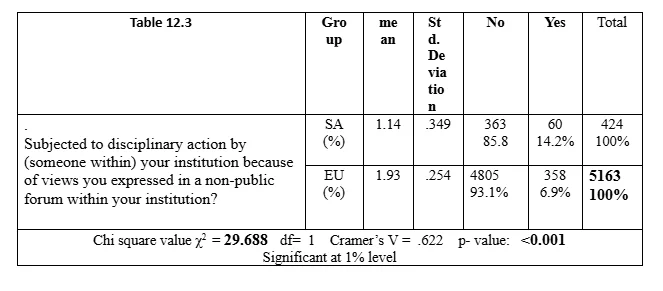
Table 12.3 gives information on inspection of the sample to see how many were subjected to disciplinary action by (someone within) their institution because of views they expressed in a non-public forum within your institution, it was found that about (14.2%) were subjected in the Saudi Arabia group compared to much lower (6.9%) in the European Union group. These differences are significantly different at 95% significance level using Chi Square test (χ2(1)= 29.688, p<0.001) with a high association coefficient (0.622) using Cramer’s V association measure. Indicating that, Saudi Arabia group respondents are significantly subjected to more disciplinary action than European Union group.

Table 12.4 shows the inspection of the sample to see how many were subjected to disciplinary action by (someone within) their institution because of views they expressed in a public forum outside their institution, it was found that about (14.6%) were subjected in the Saudi Arabia group compared to much lower (4.3%) in the European Union group. These differences are significantly different at 95% significance level using Chi Square test (χ2(1)= 29.688, p<0.001) with a high association coefficient (0.622) using Cramer’s V association measure. Indicating that, Saudi Arabia group respondents are significantly subjected to more disciplinary action than European Union group.
This question was designed to enable respondents who had been subjected to disciplinary action, or the threat of it, for expressing their academic views elsewhere, to provide details Common themes included expressing academic views. Full details of these comments are Tables (available on request), and by way of illustration, the first 10 comments are given below in table
Table 12.5: Example of “disciplinary action or the threat of disciplinary action, for academic views expressed elsewhere”

Question 16 was a composite question which asked respondents to indicate whether, because of their academic views they had ever dismissed/threatened with dismissal by (someone within) with the following:
Academic views expressed in teaching
Academic views you expressed in a research publication
Views you expressed in a non-public forum within your institution
Views you expressed in a public forum outside your institution
The results are shown in tables 13.1 to 13.4 below although there are statistically significant differences between the Saudi Arabia and European Union cohorts in three out of four instances, with respect to these questions (and the results in Tables 13.1 to 13.4) generally, it appears that the dismissed or threatened with dismissal , in most cases the proportion of staff reporting such threats is 7.5%or less. it can be seen that Saudi Arabia group respondents are significantly subjected to more dismissed or threatened with dismissal than European Union group, and Threats appear most likely to occur to Views you expressed in a non-public forum within your institution and Views you expressed in a public forum outside your institution.
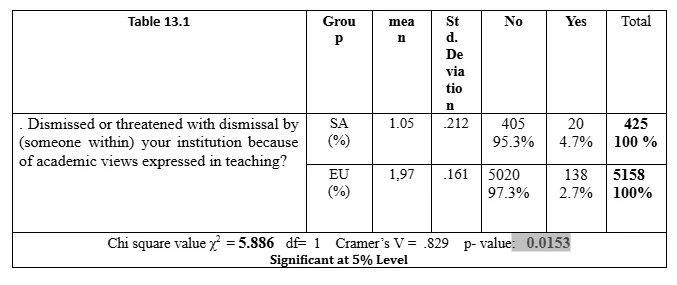
Table 13.1 represents inspection of the sample to see how many were Dismissed or threatened with dismissal by (someone within) their institution because of academic views expressed in teaching, it was found that about (4.7%) were subjected in the Saudi Arabia group compared to (2.7%) in the European Union group. These differences are significantly different at 95% significance level using Chi Square test (χ2(1)= 5.886, p=0.0153) with a high association coefficient (0.829) using Cramer’s V association measure. Indicating that, Saudi Arabia group respondents are significantly more Dismissed or threatened with dismissal than European Union group.
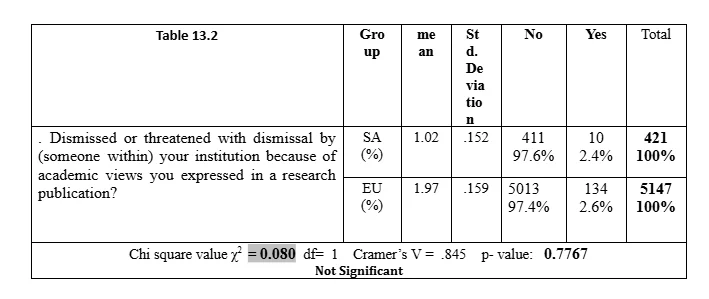
It can be seen from table 13,2 the inspection of the sample to see how many were Dismissed or threatened with dismissal by (someone within) their institution because of academic views expressed in a research publication, it was found that about (2.4%) were subjected in the Saudi Arabia group compared to (2.6%) in the European Union group. These differences are not significantly different at 95% significance level using Chi Square test (χ2(1)= 5.886, p=0.7767). Indicating that, there is no differences between Saudi Arabia group respondents and European Union group as Dismissed or threatened with dismissal.

Table 13.3 shows inspection of the sample to see how many were Dismissed or threatened with dismissal by (someone within) their institution because of views they expressed in a non-public forum within their institution, it was found that about (7.5%) were subjected in the Saudi Arabia group compared to (4.5%) in the European Union group. These differences are significantly different at 95% significance level using Chi Square test (χ2(1)= 7.851, p=0.005) with a high association coefficient (0.739) using Cramer’s V association measure. Indicating that, Saudi Arabia group respondents are significantly more Dismissed or threatened with dismissal than European Union group.
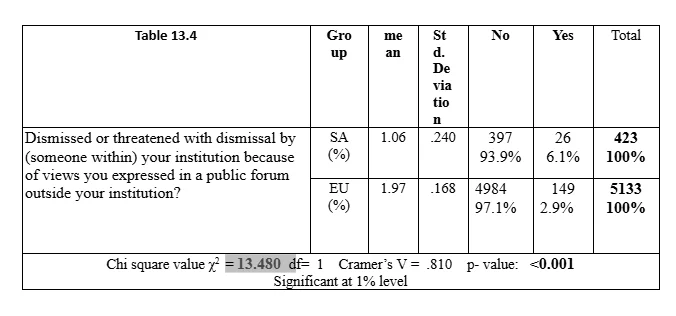
Results in table 13.4 shows inspection of the sample to see how many were Dismissed or threatened with dismissal by (someone within) their institution because of views they expressed in a public forum outside their institution, it was found that about (6.1%) were subjected in the Saudi Arabia group compared to (2.9%) in the European Union group. These differences are significantly different at 95% significance level using Chi Square test (χ2(1)= 13.480, p=0.005) with a high association coefficient (0.810) using Cramer’s V association measure. Indicating that, Saudi Arabia group respondents are significantly more Dismissed or threatened with dismissal than European Union group.
This question was designed also to enable respondents who had been subjected to dismissed/threatened with dismissal by (someone within) for expressing their academic views elsewhere, to provide details Common themes included expressing academic views. Full details of these comments are Tables (available on request), and by way of illustration, the first 10 comments are given below in table
Table 13.5: Example of “dismissed/threatened with dismissal by by (someone within) for academic views expressed elsewhere”
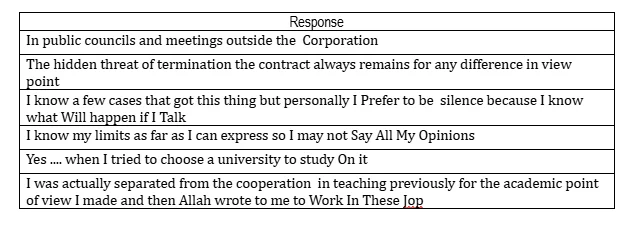
Question 17: was a composite question which asked respondents to indicate whether, because of their academic views they had ever been subjected to/threatened with the following sanctions:
Denial of promotion.
Demotion to a lower position.
Being moved to another department/centre/unit.
Being given different/fewer/additional administrative tasks.
Being given different/fewer/additional teaching or research duties.
Removal of research funding/facilities/equipment.
Bullying by academic colleagues.
Another form of sanction ( open answer)
The results are shown in tables 14.1 to 14.7 below. The first two elements of question 13 concern threats with respect to changes in the employment contract of respondents (promotion denial and demotion) for academic views expressed. As can be seen the threat of demotion is relatively uncommon - less than 5.2% of both cohorts report this occurrence. The situation with respect to denial of promotion is more common: 1 respondent in 10 among the EU cohort. The χ2 statistic shows that there are no differences between the cohorts.
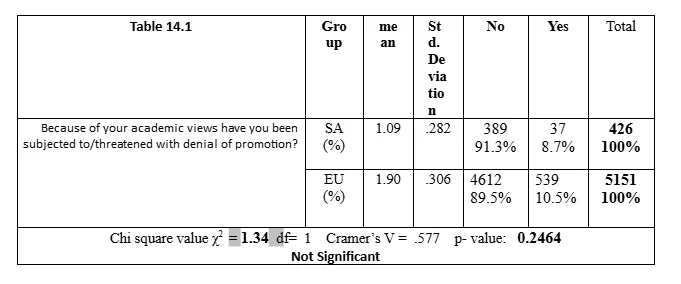
Table 14.1 represents inspection of the sample to see if Because of their academic views have you been subjected to or threatened with denial of promotion , it was found that about (8.7%) were subjected in the Saudi Arabia group compared to (10.6%) in the European Union group. These differences are not significantly different at 95% significance level using Chi Square test (χ2(1)= 1.34, p=0.2464). Indicating that, there is no difference between Saudi Arabia group respondents and European Union group as being subjected to or threatened.

Table 14.2 shows inspection of the sample to see if Because of their academic views have you been subjected to or threatened with Demotion to a lower position, it was found that about (5.2%) were subjected in the Saudi Arabia group compared to (3.5%) in the European Union group. These differences are not significantly different at 95% significance level using Chi Square test (χ2(1)= 3.05, p=0.0806). Indicating that, there is no difference between Saudi Arabia group respondents and European Union group as being subjected to or threatened. The next three elements concern threats to move staff, or to alter their administrative and teaching and research duties, because of the academic views they may hold. Table 14.3 shows that being moved to another department is a very rare event, and that its occurrence is as frequent among Saudi Arabia respondents as it is among the European Union respondents. This may be because moving to another department/center/unit would require a long process as agreeing from higher level. By contrast, as tables 14.4 and 14.5 show, being given different and/or additional tasks is a more frequent modus of sanction. 1 in 9 European Union respondents and 1 in 18 Saudi Arabia respondents reported having changes made to their administrative tasks as a form of sanction, and the difference between the two cohorts is statistically significant.

Inspection of the sample to see if Because of their academic views have you been subjected to or threatened with being moved to another department/center/unit, it was found that about (4.7%) were subjected in the Saudi Arabia group compared to (4.2%) in the European Union group. These differences are not significantly different at 95% significance level using Chi Square test (χ2(1)= 1.34, p=0.6244). Indicating that, there is no difference between Saudi Arabia group respondents and European Union group as being subjected to or threatened.

Inspection of the sample to see whether Because of your academic views they have been subjected to/threatened with being given different/fewer/additional administrative tasks, it was found that about (18.4%) were subjected in the Saudi Arabia group compared to (9.1%) in the European Union group. These differences are significantly different at 95% significance level using Chi Square test (χ2(1)= 38.536, p<0.001) with a medium association coefficient (0.545) using Cramer’s V association measure. Indicating that, Saudi Arabia group respondents are significantly subjected to or threatened more than European Union group.

Table 14.5 shows Inspection of the sample to see whether Because of your academic views they have been subjected to/threatened with being given different/fewer/additional teaching or research duties, it was found that about (16.7%) were subjected in the Saudi Arabia group compared to (10.3%) in the European Union group. These differences are significantly different at 95% significance level using Chi Square test (χ2(1)= 17.191, p<0.001) with a medium association coefficient (0.531) using Cramer’s V association measure. Indicating that, Saudi Arabia group respondents are significantly subjected to or threatened more than European Union group.

The next element of question 17 looked at threats to remove research funding and facilities, because of the academic views staff hold. Table 19.6 shows it was found that about (5.4%) were subjected in the Saudi Arabia group compared to (7.4%) in the European Union group. These differences are not significantly different at 95% significance level using Chi Square test (χ2(1)=2.256, p=0.1331). Indicating that, there is no difference between Saudi Arabia group respondents and European Union group as being subjected to or threatened. As it can be seen this is less likely to happen Perhaps because it is not under the authority of the head of the department in addition to some of researchers search from the theoretical basis and do not need equipment and units and may be due mainly to that of many researchers in Saudi Arabia are not free to conduct research alongside teaching , they are teaching full- time.
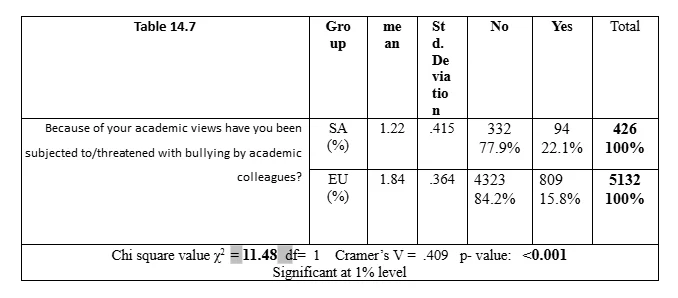
The next element of question 17 examined whether respondents were subjected to bullying because of the academic views they held. As can be seen in table 14.7it was found that about (22.1%) were subjected in the Saudi Arabia group compared to (15.8%) in the European Union group. These differences are significantly different at 95% significance level using Chi Square test (χ2(1)= 11.48, p<0.001) with a medium association coefficient (0.409) using Cramer’s V association measure. Indicating that, Saudi Arabia group respondents are significantly subjected to or threatened more than European Union group. As it can bee seen such a punishment is very likely to happen which is againts the human beeign freedom to express his thoughts and ideas, moreover, it happen in higher education where we assume that highly educated academics are exist.
This question was also designed to enable respondents who had been subjected to/threatened with another form of sanction to supply information concerning this
Table 14.8: Example of “actual or threatened disciplinary actions”

Question 19: was a composite question, which asked respondents to indicate whether, because of their academic views they have experienced restrictions of their right to travel for academic purposes (e.g. attending a conference) imposed by:
Their institution.
Their home state
A state they visited/wished to visit.
The results are shown in table below

Table 15.1 shows inspection of the sample to see whether because of their academic views they have experienced restrictions of their right to travel for academic purposes (e.g. attending a conference) imposed by their institution, it was found that about (15.9%) were subjected in the Saudi Arabia group compared to much lower (3.5%) in the European Union group. So academics in Saudi have been experienced restrictions 5 times of the European Union group These differences are significantly different at 95% significance level using Chi Square test (χ2(1)= 139.5, p<0.001) with a low association coefficient (0.158) using Cramer’s V association measure. Indicating that, Saudi Arabia group respondents are significantly have experienced restrictions of their right to travel for academic purposes more than European Union group.

Table 15.2 represents inspection of the sample to see whether because of their academic views they have experienced restrictions of their right to travel for academic purposes (e.g. attending a conference) imposed by their home state, it was found that about (4.8%) were subjected in the Saudi Arabia group compared to much lower (0.7%) in the European Union group. These differences are significantly different at 95% significance level using Chi Square test (χ2(1)= 62.2, p<0.001) with a low association coefficient (0.106) using Cramer’s V association measure. Indicating that, Saudi Arabia group respondents have significantly experienced restrictions of their right to travel for academic purposes more than European Union group.

Table 15.3 shows inspection of the sample to see whether because of their academic views they have experienced restrictions of their right to travel for academic purposes (e.g. attending a conference) imposed by a state you visited/wished to visit, it was found that about (5.8%) were subjected in the Saudi Arabia group compared to much lower (1%) in the European Union group. These differences are significantly different at 95% significance level using Chi Square test (χ2(1)= 67.4, p<0.001) with a low association coefficient (0.110) using Cramer’s V association measure. Indicating that, Saudi Arabia group respondents have significantly experienced restrictions of their right to travel for academic purposes more than European Union group.
This question was also designed to enable respondents who have experienced restrictions of their right to travel for academic purposes because of their academic views to supply information concerning this.
Table 15.4: Example of “restrictions of their right to travel for academic purposes’

Question 20 was a composite question, which asked respondents to indicate whether, because of their academic views they have been threatened with legal action by:
Their institution.
An academic not working at their institution
The results are shown in table below.

Table 16.1 represents inspection of the sample to see whether because of their academic views they have been threatened with legal action by their institution, it was found that about (5.3%) were subjected in the Saudi Arabia group compared to (1.8%) in the European Union group. These differences are significantly different at 95% significance level using Chi Square test (χ2(1)= 21.8, p<0.001) with a low association coefficient (0.063) using Cramer’s V association measure. Indicating that, Saudi Arabia group respondents have been significantly threatened with legal action more than European Union group.

Table 16.2 shows inspection of the sample to know whether, because of their academic views they have been threatened with legal action by an academic not working at your institution, it was found that about (1%) were subjected in the Saudi Arabia group compared to (1%) in the European Union group. These differences are not significantly different at 95% significance level using Chi Square test (χ2(1)=0.003, p=0.95). Indicating that, there is no difference between Saudi Arabia group respondents and European Union group as being threatened with legal action.
This question was also designed to enable respondents who have been threatened with legal action because of their academic views to supply information concerning this.
Table 16.3: Example of “threatened with legal action”

Question 21 was a composite question, which asked respondents to indicate whether, because of their academic views they have ever been refused publication of an article/book/book chapter or participation in a conference by:
Their institution.
The state authorities?

Table 17.1 gives information on inspection of the sample to see whether because of their academic views they have ever been refused publication of an article/book/book chapter or participation in a conference by their institution, it was found that about (3.3%) were subjected in the Saudi Arabia group compared to (1.7%) in the European Union group. These differences are significantly different at 95% significance level using Chi Square test (χ2(1)= 5.6, p=0.018) with a low association coefficient (0.032) using Cramer’s V association measure. Indicating that, Saudi Arabia group respondents have been significantly refused publication more than European Union group.
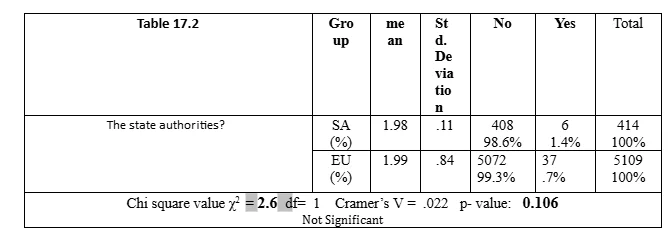
Table 17.2 shows inspection of the sample to know whether, because of their academic views they have ever been refused publication of an article/book/book chapter or participation in a conference by the state authorities, it was found that about (1.4%) were subjected in the Saudi Arabia group compared to (0.7%) in the European Union group. These differences are not significantly different at 95% significance level using Chi Square test (χ2(1)=2.6, p=0.106). Indicating that, there is no difference between Saudi Arabia group respondents and European Union group in refused publication.
This question was also designed to enable respondents who have ever been refused publication of an article/book/book chapter or participation in a conference because of their academic views to supply information concerning this.
Table 17.3: Example of “have ever been refused publication of an article/book/book chapter or participation in a conference”

Question 22 was a composite question, which asked respondents to indicate whether, because of their academic views they ever have:
Been subjected to/threatened with physical harm by (someone within) your institution?
Been subjected to/threatened with psychological pressure by (someone within) your institution?
Been subjected to/threatened with sexual abuse or assault by (someone within) your institution?
Been subjected to/threatened with sexual harassment (e.g. derogatory remarks) by (someone within) your institution?
Had false charges brought against you by (someone within) your institution?
The results are given in tables 18.1 to 18.5 below

The first statement of question 22 concern threats of physical harm. As can been seen from table 22.1, occurrences of physical harm are very rare indeed – less than 1.5% of respondents from both cohorts Saudi Arabia group and the European Union group reported this form of physical threat .These differences are not significantly different at 95% significance level using Chi Square test (χ2(1)= 0.766, p=0.38147). Indicating that, there is no difference between Saudi Arabia group respondents and European Union group as being subjected to or threatened.

The situation with regard to psychological pressure is, however, very different. Table 18.2 shows that Inspection of the sample to see if because of their academic views they have ever been subjected to/threatened with psychological pressure by (someone within) their institution, it was found that about (18.9%) were subjected in the Saudi Arabia group compared to (16.5%) in the European Union group. These differences are not significantly different at 95% significance level using Chi Square test (χ2(1)= 1.66, p=0.1966). Indicating that, there is no difference between Saudi Arabia group respondents and European Union group as being subjected to or threatened.
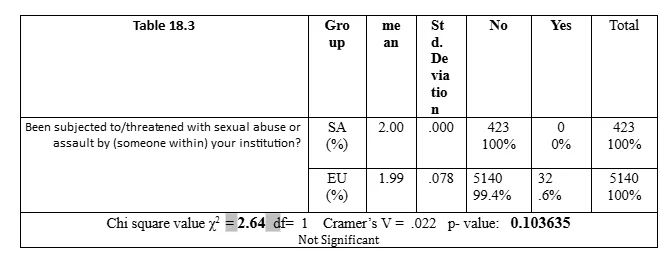
The next elements concern threats of sexual abuse, assault and harassment. Table 18.3 shows that the experience of, or threat of, sexual abuse or assault is even more rare than physical harm. It was found that non (0%) were subjected in the Saudi Arabia group compared to (0.6%) in the European Union group. These differences are not significantly different at 95% significance level using Chi Square test (χ2(1)= 2.64, p=0.1036). Indicating that, there is no difference between Saudi Arabia group respondents and European Union group as being subjected to or threatened.

The forth elements can be seen in table 18.4 concern if the sample because of their academic views they have ever been subjected to/threatened with sexual harassment (e.g. derogatory remarks) by (someone within) their institution, it was found that about (0.7%) were subjected in the Saudi Arabia group compared to (2.7%) in the European Union group. These differences are significantly different at 95% significance level using Chi Square test (χ2(1)= 6.26, p=0.012) with a low association coefficient (0.032) using Cramer’s V association measure. Indicating that, European Union group respondents have been significantly subjected to or threatened more than Saudi Arabia group.

The final element of question 22 looked at the threat of legal charges being brought against an individual because of their academic views. Table 18.5 shows Inspection of the sample. it was found that about (19.4%) were subjected in the Saudi Arabia group compared to much lower (6.6%) in the European Union group. These differences are significantly different at 95% significance level using Chi Square test (χ2(1)= 91.1, p<0.001) with a low association coefficient (0.128) using Cramer’s V association measure. Indicating that, Saudi Arabia group respondents have had false charges brought against them significantly more than European Union group.
This question was also designed to enable respondents who have ever been because of their academic views have been subjected to physical harm , psychological pressure , threatened with sexual abuse or assault , threatened with sexual harassment and threatened with charges being brought to supply information concerning this.
Table 18.6: Example of subjected to physical harm , psychological pressure , threatened with sexual abuse or assault , threatened with sexual harassment and threatened with charges being brought

Question 23 was a composite question, which asked respondents to indicate whether, because of their academic views they have been subjected to pressure to amend/not to publish any proposed publication or to change/not present an academic talk by:
Their institution.
Another academic
Freedom of expression is an inherent human concept to express their views and opinion without fear or aspect of intimidation. In many countries, Freedom to express personal view is highly suppressed especially those nations with authoritarian form of government such as Saudi Arabia. Recently a prominent lecturer was compelled to go on exile expressing fear that he would be arrested due to his political views if he decide to return into the country. Many academic are currently facing torture, trials or other forms of ill-treatments due to their views against the government. A lot of study shows instances where academic have been coerced to write and publish articles against their will. Others have been forced to pull down published articles especially when the government feels undermined by the views. The table below shows analysis of different responses from two different countries.
The results are shown in table 19.1 to 19.2 below

Looking at table 19.1 it shows inspection of the sample to see whether because of their academic views they have been subjected to pressure to amend/not to publish any proposed publication or to change/not present an academic talk by their institution, it was found that about (6.4%) were subjected in the Saudi Arabia group compared to much lower (3.3%) in the European Union group. Saudi group were nearly twice the European Union group .These differences are significantly different at 95% significance level using Chi Square test (χ2(1)= 11.5, p<0.001) with a low association coefficient (0.046) using Cramer’s V association measure. Indicating that, Saudi Arabia group respondents have had been subjected to pressure to amend/not to publish any proposed publication or to change/not present an academic talk by their institution.

Table 19.2 represents inspection of the sample to see if they have been subjected to pressure to amend/not to publish any proposed publication or to change/not present an academic talk because of their academic views by another academic, it was found that about (5.7%) were subjected in the Saudi Arabia group compared to (8.2%) in the European Union group. These differences are not significantly different at 95% significance level using Chi Square test (χ2(1)= 3.25, p=0.07). Indicating that, there is no difference between Saudi Arabia group respondents and European Union group as being subjected to pressure to amend/not to publish any proposed publication or to change/not present an academic talk by another academic.
This question was also designed to enable respondents who had have been subjected to pressure to amend/not to publish any proposed publication or to change/not present an academic talk because of their academic views to supply information concerning this.
Table 19.3 Example of subjected to pressure to amend/not to publish any proposed publication or to change/not present an academic talk

Question 24 "Have you ever practiced self-censorship (that is, refrained from publishing, teaching, talking or doing research on a particular topic, for fear of negative repercussions, such as loss of privileges, demotion, physical harm, etc.)?",
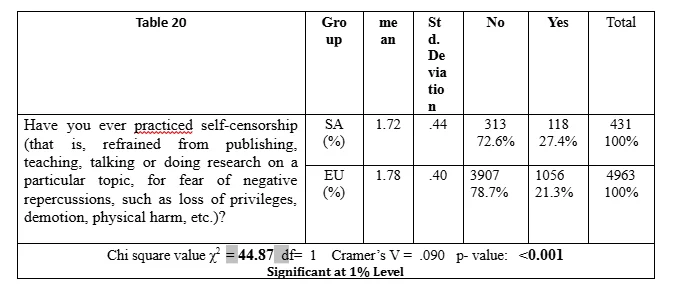
the results are shown in Table 20 above, which presents the responses in number and percentage, where 27.4% of SA and 21% of EU responses agrees to that they had been practiced censorship, there is significant difference between SA and EU at Level of significant 1% for.
Question 25 was a composite question, which asked respondents to indicate whether, because of their academic views they have experienced, or been threatened with, infringement of their academic freedom in their institution because of their:
Gender
Race
Political views
Membership of an ethnic minority
In this question it was denoted that academic freedom in many institutions of higher learning is affected by gender, race, political views or membership of an ethnic minority. In Saudi Arabia, a lot of study shows that the academic freedom of some faculty members have been infringed due to their races, gender, or political views. Some academics have been denied the freedom to publish their research due to political views that is perceived to be non-grata. Additionally, a lot of cases have been reported where faculty members have been victimised and their academic freedom encroached due to their races. Victimisation of academic freedom due to race, gender and political view is uncalled for and should be battled at all cost. The table below shows analysis of responses from various respondents.
The results are shown in table 21.1 to 21.4 below. these are consider as individual attributes of staff which should not have any impact to their academic freedom. Although the figure is not that high in Saudi Arabia that kind of threatened with, infringement of their academic freedom in their institution because of specially (gender , race and Membership of an ethnic minority) should not exist in Muslim community , as the religion of Islam have a great value that The origin of equality between people is due to humanity. There is no difference between male and female, Arab or non-Arab, white or black except with piety. the Prophet Mohammed affirmed that all people are equal like the teeth of a comb and that no Arab is superior to a non-Arab, nor is a white person superior to a black person, unless by virtue of personal integrity and moral rectitude .

Table 21.1 reflect inspection of the sample to see whether because of their academic views they have experienced, or been threatened with, infringement of their academic freedom in their institution because of their gender, it was found that about (5.9%) were subjected in the Saudi Arabia group compared to much lower (1.4%) in the European Union group. That means 1 in nearly 6 in Saudi affected .These differences are significantly different at 95% significance level using Chi Square test (χ2(1)= 44.87, p<0.001) with a low association coefficient (0.090) using Cramer’s V association measure. Indicating that, Saudi Arabia group respondents experienced, or been threatened with, infringement of their academic freedom significantly more than European Union group.

Table 21.2 shows inspection of the sample to see whether because of their academic views they have experienced, or been threatened with, infringement of their academic freedom in their institution because of their race, it was found that about (7.6%) were subjected in the Saudi Arabia group compared to much lower (0.3%) in the European Union group. These differences are significantly different at 95% significance level using Chi Square test (χ2(1)= 236.6, p<0.001) with a low association coefficient (0.206) using Cramer’s V association measure. Indicating that, Saudi Arabia group respondents experienced, or been threatened with, infringement of their academic freedom significantly more than European Union group.

Table 21.3 details inspection of the sample to see whether because of their academic views they have experienced, or been threatened with, infringement of their academic freedom in their institution because of their political views, it was found that about (5.7%) were subjected in the Saudi Arabia group compared to (2.7%) in the European Union group. These differences are significantly different at 95% significance level using Chi Square test (χ2(1)= 12.18, p<0.001) with a low association coefficient (0.047) using Cramer’s V association measure. Indicating that, Saudi Arabia group respondents experienced, or been threatened with, infringement of their academic freedom significantly more than European Union group.

Table 21.4 represents inspection of the sample to see whether because of their academic views they have experienced, or been threatened with, infringement of their academic freedom in their institution because of their membership of an ethnic minority, it was found that about (4.8%) were subjected in the Saudi Arabia group compared to (0.6%) in the European Union group. These differences are significantly different at 95% significance level using Chi Square test (χ2(1)= 76.12, p<0.001) with a low association coefficient (0.117) using Cramer’s V association measure. Indicating that, Saudi Arabia group respondents experienced, or been threatened with, infringement of their academic freedom significantly more than European Union group.
This question invited those respondents who had been subjected to/ threatened with infringement of academic freedom on account of some other reason to provide more detailed information about the reason their academic freedom had been negated.
Table 21.5: Examples of threatened because of other reasons (gender, race..)

Question 26 was a composite question which required respondents to utilise a five point scale to indicate their relative agreement/disagreement with the following statements:
Individual academic freedom for teaching is very important to me.
Individual academic freedom for teaching has declined in my institution in recent years.
Individual academic freedom for research is very important to me.
Individual academic freedom for research has declined in my institution in recent years.
My institution’s autonomy (i.e. the widest practical measure of freedom from state regulation) is very important to me.
Institutional autonomy has declined in my institution in recent years.
Self-governance (i.e. the right of academic staff to participate in the governance of a higher education institution) in my institution is very important to me.
Self-governance has declined in my institution in recent years.
Employment protection for academic staff in my institution (i.e. permanent contracts, which are not easily terminable for institutional reasons) is very important to me.
Employment protection for academic staff in my institution has declined in recent years.
The commercialisation of higher education is of great concern to me.
The commercialisation of higher education has increased in recent years
The results are shown in tables 22.1 to 22.12 below.
This question addressed the importance respondents’ attached to the substantive (freedom for teaching, freedom for academic freedom), and supportive elements (institutional autonomy, self-governance and employment protection) of academic freedom and whether they believed that these had declined in recent years.

Table 22.1 reflects respondents to the first substantive elements ( freedom for ), whether Individual academic freedom for teaching is very important to them. There exists a significant difference between the two groups among the 5-levels of agreement using chi square test (χ2 (4) = 20.2, p<0.001) with an association coefficient (0.06) using Cramer’s V association measure. Disagreement level is about (1.4%) for Saudi Arabia group compared to (0.5%) for European Union group, while agreement level is (91.7%) for Saudi Arabia group compared to (95.9%) for European Union group, Moreover, there exist about (6.9%) as neutral for Saudi Arabia group compared to (3.6%) for European Union group. On the other hand, there is no significant difference between the mean value for Saudi Arabia group and European Union group with 1.49 and 1.42 respectively. The t-test is used as a significance test as (t(5534)= 1.946 , p=0.05) impling that there is no difference between the two means at 1% significance level.
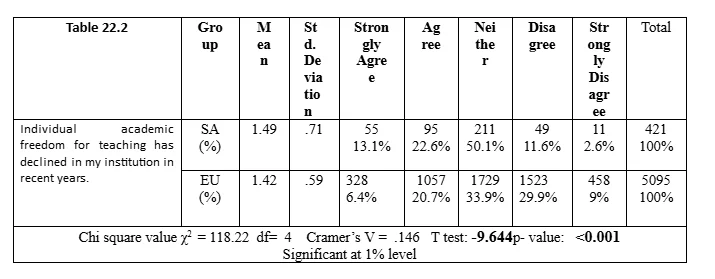
Looking at table 22.2 it shows respondents whether individual academic freedom for teaching has declined in their institution in recent years. There exist a significant difference between the two groups among the 5-levels of agreement using chi square test (χ2 (4) = 118.22, p<0.001) with association coefficient (0.146) using Cramer’s V association measure. Disagreement level is about (14.2%) for Saudi Arabia group compared to (38.9%) for European Union group, while agreement level is (35.7%) for Saudi Arabia group compared to (27.1%) for European Union group, Moreover, there exist about (50.1%) as neutral for Saudi Arabia group compared to (33.9%) for European Union group. On the other hand, if the question is looked at as scale, the mean value for Saudi Arabia group (µ1=1.49) is higher than European Union group (µ2=1.42) and have a significant difference using t-test at 1% significance level (t(5514)=-9.644, p<0.001) indicating higher general agreement level for European Union group.

Table 22.3 represents the second substantive elements (freedom for research) Asking respondents whether Individual academic freedom for research is very important to them. There exist a significant difference between the two groups among the 5-levels of agreement using chi square test (χ2 (4) = 97.89, p<0.001) with association coefficient (0.120) using Cramer’s V association measure. Disagreement level is about (1.7%) for Saudi Arabia group compared to (0.4%) for European Union group, while agreement level is (91.9%) for Saudi Arabia group compared to (97.6%) for European Union group, Moreover, there exist about (6.4%) as neutral for Saudi Arabia group compared to (2%) for European Union group. On the other hand, if the question is looked at as scale, the mean value for Saudi Arabia group (µ1=1.55) is higher than European Union group (µ2=1.30) and have a significant difference using t-test at 1% significance level (t(5518)=6.844, p<0.001) indicating higher general agreement level for European Union group.

Table 22.4 reflects staff beliefs with regards to whether Individual academic freedom for research has declined in their institution in recent years. There exists a significant difference between the two groups among the 5-levels of agreement using chi square test (χ2 (4) = 103.5, p<0.001) with association coefficient (0.137) using Cramer’s V association measure. Disagreement level is about (17.1%) for Saudi Arabia group compared to (36.1%) for European Union group, while agreement level is (30.6%) for Saudi Arabia group compared to (31.9%) for European Union group, Moreover, there exist about (52.3%) as neutral for Saudi Arabia group compared to (31.9%) for European Union group. On the other hand, if the question is looked at as scale, the mean value for Saudi Arabia group (µ1=2.78) is less than European Union group (µ2=3.05) and have a significant difference using t-test at 1% significance level (t(5515)=-5.771, p<0.001) indicating higher general agreement level for Saudi Arabia group.
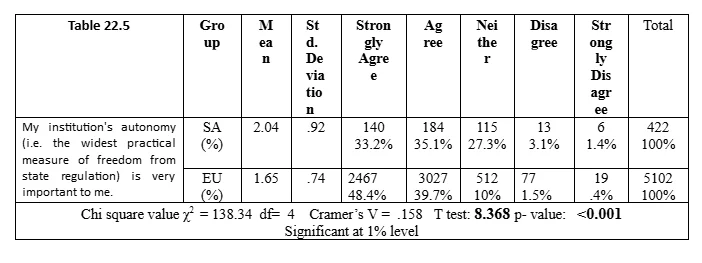
Table 22.5 shows supportive elements of academic freedom (autonomy) Asking staff whether their institution's autonomy (i.e. the widest practical measure of freedom from state regulation) is very important to them. There exists a significant difference between the two groups among the 5-levels of agreement using chi square test (χ2 (4) = 138.34, p<0.001) with association coefficient (0.158) using Cramer’s V association measure. Disagreement level is about (4.5%) for Saudi Arabia group compared to (1.9%) for European Union group, while agreement level is (68.3%) for Saudi Arabia group compared to (88.1%) for European Union group, Moreover, there exist about (27.3%) as neutral for Saudi Arabia group compared to (10%) for European Union group. On the other hand, if the question is looked at as scale, the mean value for Saudi Arabia group (µ1=2.04) is higher than European Union group (µ2=1.65) and have a significant difference using t-test at 1% significance level (t(5522)=8.368, p<0.001) indicating higher general agreement level for European Union group. That could be because universities in Saudi Arabia is still not fully independent .moreover, it is sill a new concept between academics in Saudi Arabia.

Table 22.6 shows respondents to whether their Institutional autonomy has declined in their institution in recent years. There exists a significant difference between the two groups among the 5-levels of agreement using chi square test (χ2 (4) = 81.83, p<0.001) with an association coefficient (0.122) using Cramer’s V association measure. Disagreement level is about (14.8%) for Saudi Arabia group compared to (24.3%) for European Union group, while agreement level is (32.2%) for Saudi Arabia group compared to (43.9%) for European Union group, Moreover, there exist about (53.1%) as neutral for Saudi Arabia group compared to (32%) for European Union group. On the other hand, there is no significant difference between the mean value for Saudi Arabia group and European Union group with an equal value of 2.74. The t-test is used as a significance test as (t(5507)= 0.166 , p=0.91) impling that there is no difference between the two means at 1% significance level.
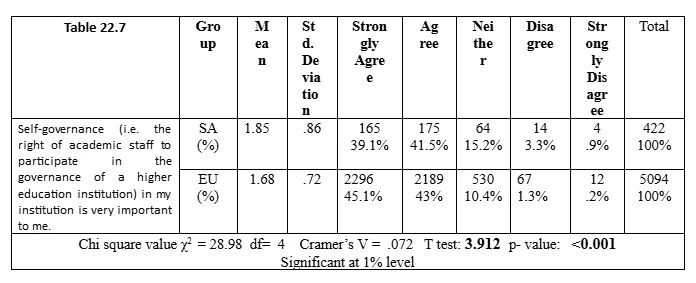
Table 22.7 shows the second supportive elements of academic freedom (governance), asking respondents whether Self-governance (i.e. the right of academic staff to participate in the governance of a higher education institution) in their institution is very important to them. There exists a significant difference between the two groups among the 5-levels of agreement using chi square test (χ2 (4) = 28.98, p<0.001) with an association coefficient (0.72) using Cramer’s V association measure. Disagreement level is about (4.2%) for Saudi Arabia group compared to (1.5%) for European Union group, while agreement level is (80.6%) for Saudi Arabia group compared to (88.1%) for European Union group, Moreover, there exist about (15.2%) as neutral for Saudi Arabia group compared to (10.4%) for European Union group. On the other hand, if the question is looked at as scale, the mean value for Saudi Arabia group (µ1=1.85) is higher than European Union group (µ2=1.68) and have a significant difference using t-test at 1% significance level (t(5514)=3.912, p<0.001) indicating higher general agreement level for European Union group.

Table 22.8 represents academics belief to whether Self-governance has declined in their institution in recent years. There exists a significant difference between the two groups among the 5-levels of agreement using chi square test (χ2 (4) = 59.03, p<0.001) with an association coefficient (0.103) using Cramer’s V association measure. Disagreement level is about (13.9%) for Saudi Arabia group compared to (23.6%) for European Union group, while agreement level is (35.8%) for Saudi Arabia group compared to (44%) for European Union group, Moreover, there exist about (50.2%) as neutral for Saudi Arabia group compared to (32.5%) for European Union group. On the other hand, there is no significant difference between the mean value for Saudi Arabia group and European Union group with a mean value of 2.66 and 2.68 respectively. The t-test is used as a significance test as (t(5512)= -0.360 , p=0.72) implying that there is no difference between the two means at 1% significance level.

Table 22.9 shows the third supportive elements of academic freedom (tenure), asking respondents whether Employment protection for academic staff in their institution, notably tenure (i.e. permanent contracts, which are not easily terminable for institutional reasons. There exists a significant difference between the two groups among the 5-levels of agreement using chi square test (χ2 (4) = 158.8, p<0.001) with an association coefficient (0.117) using Cramer’s V association measure. Disagreement level is about (2.9%) for Saudi Arabia group compared to (1.8%) for European Union group, while agreement level is (74.3%) for Saudi Arabia group compared to (91.2%) for European Union group, Moreover, there exist about (22.8%) as neutral for Saudi Arabia group compared to (7.2%) for European Union group. On the other hand, if the question is looked at as scale, the mean value for Saudi Arabia group (µ1=1.96) is higher than European Union group (µ2=1.55) and have a significant difference using t-test at 1% significance level (t(5520)=11.115, p<0.001) indicating higher general agreement level for European Union group.

Table 22.10 shows address whether Employment protection and tenure for academic staff in my institution has declined in recent years. There exists a significant difference between the two groups among the 5-levels of agreement using chi square test (χ2 (4) = 55.7, p<0.001) with an association coefficient (0.101) using Cramer’s V association measure. Disagreement level is about (19.5%) for Saudi Arabia group compared to (23.3%) for European Union group, while agreement level is (39.3%) for Saudi Arabia group compared to (52%) for European Union group, Moreover, there exist about (41.2%) as neutral for Saudi Arabia group compared to (24.7%) for European Union group. On the other hand, if the question is looked at as scale, the mean value for Saudi Arabia group (µ1=2.68) is higher than European Union group (µ2=2.53) and have a significant difference using t-test at 1% significance level (t(5509)=2.728, p<0.001) indicating higher general agreement level for European Union group.

Table 22.11 reflects whether Employment protection and tenure for academic staff in my institution has declined in recent years. There exists a significant difference between the two groups among the 5-levels of agreement using chi square test (χ2 (4) = 162.8, p<0.001) with an association coefficient (0.172) using Cramer’s V association measure. Disagreement level is about (15.6%) for Saudi Arabia group compared to (14.4%) for European Union group, while agreement level is (40.9%) for Saudi Arabia group compared to (66.8%) for European Union group, Moreover, there exist about (43.5%) as neutral for Saudi Arabia group compared to (18.9%) for European Union group. On the other hand, if the question is looked at as scale, the mean value for Saudi Arabia group (µ1=2.61) is higher than European Union group (µ2=2.16) and have a significant difference using t-test at 1% significance level (t(5499)=8.852, p<0.001) indicating higher general agreement level for European Union group.

From table 22.12 it can be seen how staff answered to the statement ‘The commercialization of higher education has increased in recent years.’ There exists a significant difference between the two groups among the 5-levels of agreement using chi square test (χ2 (4) = 160.9, p<0.001) with an association coefficient (0.171) using Cramer’s V association measure. Disagreement level is about (11.9%) for Saudi Arabia group compared to (7.6%) for European Union group, while agreement level is (42.9%) for Saudi Arabia group compared to (71%) for European Union group, Moreover, there exist about (45.2%) as neutral for Saudi Arabia group compared to (21.3%) for European Union group. On the other hand, if the question is looked at as scale, the mean value for Saudi Arabia group (µ1=2.6) is higher than European Union group (µ2=2.08) and have a significant difference using t-test at 1% significance level (t(5509)=10.887, p<0.001) indicating higher general agreement level for European Union group. Where in the European Union group students have to pay tuition fee, students in Saudi Arabia do not pay any tuition fee additionally the government support them with monthly nearly 200 GBP for Scientific studies and 160 GBP for Humanities studies.
Question 27 the final question in this section invited respondents to make any further comments concerning their experience of academic freedom.
Table 23: of further comments on experience of academic freedom

Section C – The Demographic Characteristics of Respondents
Question 28 asked about the gender of the respondents,

Males accommodate (54.1%) in the Saudi Arabia Sample group and significantly more (60.9%) for the European Union sample group, respectively (45.9%) and (39.1%) females.
Question 29 asked about the year of birth of the respondents, and the data was re-calibrated to get the age of the cohorts
In Saudi Arabia, the population is divided into various age groups. The age 1-20 contains the population median with a ratio of 1.05 males per female. Age 21-50 which is the middle age group forms the largest share of the total population. It is approximated to be in the ratio of 1.03 males per female. Lastly, age 50 and over are the largest majority in the labour market. Majority of this population are in various institutions either taking postgraduates degrees or working as Lecturers and professors. The table below shows various respondents’ ages from various institutions in Saudi Arabia and EU.

Age is normally distributed for Saudi Arabia group with lowest distribution for less than 30 years (6.6%) and 60 or more (5.6%) then the distribution is mostly concentrated for ages between 30 to 39 (38.5%). On the other hand, the distribution is much different for European Union group as the highest distribution is for age group 60 and more (32.3%) whereas there is too few in age group less than 30 (1.7%) and second least for ages between 30 to 39 (12.3%).These differences are significantly different using chi square test (χ2(9)=320.8, p<0.001) at 95% significance level .
Question 30 "What is your ethnic background?"
Statistical figures shows that 90 per cent of the people taking various degree programs in various institutions of higher learning are Arabs. Mixed Asian people and African ancestry forms the largest minority, whilst 34 per cent of all residents are foreign born. Other than Syrians and Indians there are smaller ethnic groups present who come to pursue various degrees. They include Egyptians, Sudanese, Algerians, Pakistanis and Filipinos. The table below shows various analysis of data from various respondents.

Regarding the ethnic background, the absolute majority is for Saudi (72.91%), followed by Egyptian (10.63%) and Jordanian (7.85%) with the least distribution for Yamani and Italian as (0.25%) each.
Question 33 asked about the period that the subjects had worked in their present institution. The most of respondents indicated that they have worked from 1 to 10 years for both cohorts as indicated in table below.

Table 26 represent staff answers to a question about the period that the subjects had worked in their present institution, the highest portion in Saudi Arabia group is for working between 1 to 5 years (39.8%) compared to (20.9%) for the European Union group also as the highest portion. This is followed for both groups by working between 6 to 10 years for Saudi Arabia group (24%) compared to (19.6%) for European Union group. Nevertheless, in accordance with age distribution there is more in the European Union group that have worked for more than 25 years ( 16.3%) compared to Saudi Arabia group. These differences are significantly different using chi square test (χ2(6)=103.33, p<0.001) at 95% significance level .
Question 34 "What is your official job title (Professor, Associate/Assistant Professor, Reader, Lecturer, Research Fellow, etc.)?"

Table 27 shows Inquiring about official job title for Saudi Arabia group, the highest portion is working as assistant professor (30.29%) followed by Lecturer (29.33%). On the other hand, professor and associate professor accommodate for less, together as (25.97%). There is only one researcher and few other titles not accounting for (1%).
Question 35 "What is/are your broad teaching/research discipline(s)?”
Question 35 was designed for SA survey to ask about their broad teaching/research discipline. It is worth noting that many students in various universities in Saudi Arabia often prefer taking humanities to scientific courses. This is due to major challenges that are facing the field of scientific research. The issue of funding scientific projects is a major problem in the field of research, as such, a lot of student feel that pursuing scientific courses would put them into future challenges. A number of scholars have acknowledged that funding of scientific research programs is a major problem faced by faculty members across all the institution of higher learning. In a recent study, the researchers agreed that as much as the state have been putting a lot of effort to fund institutions of higher learning still much is needed to be done in terms of research infrastructure and its connection to the society. According to the respondents, majority of the private and public sectors are reluctant to invest in scientific research due to lack of faith in it. Additionally, low incentives and salaries is another reason for the weak scientific research. It has emerged that many faculty members who take their time carrying out extensive research have suffered low salary scale for a long time, this has scared away many potential researchers. The table below shows the number of responses provided in various field of study.
Table 28: Subject Disciplines of Respondents (Saudi Arabia only)
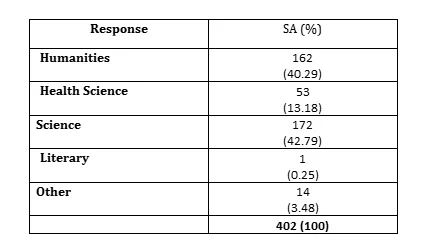
Table 28 shows distribution of broad teaching or research discipline is concentrated for Science (42.79%) and Humanities as (40.29%). Nevertheless there is about (13.18%) teaching Health science and only one for Literary. Other discipline exists as well with a percentage about (3.48%).
Question 36 asked subjects if they had full or part-time positions
Table 29: Present Position

Question 36 asked respondents to indicate whether they had full or part-time positions. As can be seen from table 29, most respondents in Saudi Arabia group have full time position (88.8%) compared to European Union group (84.6%), while more European Union group have part time positions (11%) compared to Saudi Arabia group (2.6%). These differences are significantly different using chi square test (χ2(2)=41.25, p<0.001) at 95% significance level .
Question 37 asked subjects about the type of their contract.
Table 30: type of the contract

Question 37 asked respondents to indicate type of their contract as it can be seen from table 30 respondents in Saudi Arabia group have permanent contract (68.8%) compared to European Union group (66.4%), while more European Union group have fixed-term contracts (28%) compared to Saudi Arabia group (22.3%). These differences are significantly different using chi square test (χ2(2)=11.57, p=0.003) at 95% significance level .
Question 38 "If you are employed under a fixed-term contract, what is the total duration of the contract?"

Question 39 "Are you on a tenure-track position, i.e. will you obtain a permanent and secure position at some future point subject to an evaluation of your academic competence?"

Asking the respondents whether they will obtain a permanent and secure position at some future point subject to an evaluation of your academic competence (on a tenure-track position), from table 31 it was found that about (17.1%) on a tenure-track position in the Saudi Arabia group compared to (26.4%) in the European Union group. This difference is significantly different at 95% significance level using Chi Square test (χ2(1)= 17.004, p<0.001). Indicating that there is a significant difference between European Union group respondents compared to Saudi Arabia group on a tenure-track position.
Question 40 "If your contract of employment envisages a probationary period, what is the total duration thereof

Question 41 was a composite question, which asked respondents to indicate the reasons of their contract that can be terminated, by the following reasons:
Very serious misconduct.
Other (less serious) disciplinary reasons.
As a result of negative assessments of the quality of they work by my employer.
As a result of institutional reasons
For other reasons
uncertain or don’t know
This question required the respondent give reasons why at one given time they were dismissed from job. Dismissal of employees from institutions of higher learning is quite a complex and lengthy process, as such, a concrete evidence that meets a given threshold must be provided in order for such cases to be admissible in a court of law. However, every institution institutes their own internal organ that is mandated to assess and scrutinise the conduct of the staff and faculty members. In an event the commissioned committee finds it convincing beyond any reasonable doubt to dismiss an employee following the evidence presented, then they would not hesitate to do so. During the research, different respondents provided various reasons that led to their dismissal from job, among them included gross misconduct and other institutional reasons. The table below shows analysis of results from various respondents.
The results are shown in tables below.

Table 32.1 details participants respondents to the reasons of their contract that can be terminate as uncertain or don’t know the reason, it was found that about (29.2%) from Saudi Arabia group believe so compared to (9.6%) in the European Union group. The difference is significantly different at 95% significance level using Chi Square test (χ2(1)= 152, p<0.001). Indicating that, Saudi Arabia group respondents significantly believe that more than European Union group.

Table 32.2 shows participants’ respondents to indicate the reasons of their contract that can be terminate for Very serious misconduct it was found that about (57.2%) from Saudi Arabia group believe so compared to (56.3%) in the European Union group. The difference is not significantly different at 95% significance level using Chi Square test (χ2(1)= 0.126, p<0.001).Indicating no differences between Saudi Arabia group and European Union group.
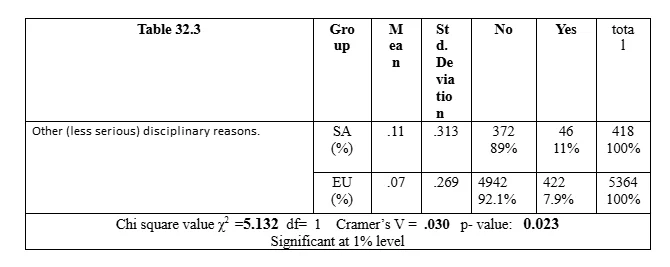
Table 32.3 represents the respondents indication to the reasons of their contract that can be terminate for Other (less serious) disciplinary reasons, it was found that about (11%) from Saudi Arabia group believe so compared to (7.9%) in the European Union group. The difference is significantly different at 95% significance level using Chi Square test (χ2(1)= 5.132, p=0.023). Indicating that, Saudi Arabia group respondents significantly believe that more than European Union group.

Table 32.4 reflects respondents to indication to the reasons of their contract that can be terminate as a result of negative assessments of the quality of my work by my employer, it was found that about (19.8%) from Saudi Arabia group believe so compared to (8.4%) in the European Union group. The difference is significantly different at 95% significance level using Chi Square test (χ2(1)= 33.013, p<0.001). Indicating that, European Union group respondents significantly believe that more than Saudi Arabia group.

Table 32.5 3 represents the respondents indication to the reasons of their contract that can be terminate as a result of institutional reasons, it was found that about (20.8%) from Saudi Arabia group believe so compared to (38.9%) in the European Union group. The difference is significantly different at 95% significance level using Chi Square test (χ2(1)= 54.11, p<0.001). Indicating that, European Union group respondents significantly believe that more than Saudi Arabia group
Section D – About the Academic Work and Responsibilities:
Question 42 "Have you ever held a post in a higher education institution with administrative/managerial responsibilities (e.g., Departmental Head, Dean)?"
This question required the respondents give their responses on whether they have at one given time held a position in an institution of higher learning. Research shows that majority of the employed team stay in job position for longer duration thus blocking chances of employing new faces. This has made it difficult to secure job of higher rank such as head of department. Additionally when such vacancies are created, heads of institutions prefer to recommend existing and experienced figures within a given department. One respondent admitted the fact that he has stayed in the university for a very long time but he has failed to move to a higher rank. The table below shows analysis of results from various respondents.

Table 33 details responses that participant gave when they been asked whether they have ever held a post in a higher education institution with administrative/managerial responsibilities (e.g., Departmental Head, Dean), it was found that about (40.1%) from Saudi Arabia group have held administrative/managerial responsibilities so compared to (33.1%) in the European Union group. The difference is significantly different at 95% significance level using Chi Square test (χ2(1)=8.77, p<0.001). Indicating that, Saudi Arabia group respondents significantly more higher than European Union group
Question 43 "If your answer to the previous question has been affirmative, please specify the title of the post(s) in the textbox below."

Question 44 "Do you now hold a post with administrative/managerial responsibilities (e.g., Departmental Head, Dean)?"

Table 34details responses that participant gave when they been asked whether they are currently holding a post with administrative/managerial responsibilities (e.g., Departmental Head, Dean), it was found that about (21.1%) from Saudi Arabia group are holding administrative/managerial responsibilities compared to (17.3%) in the European Union group. The difference is significantly different at 95% significance level using Chi Square test (χ2(1)=3.97, p<0.001). Indicating that, Saudi Arabia group respondents significantly higher than European Union group
Question 45 "If your answer to the previous question has been affirmative, please specify the title of the post in the textbox below."

Question 46 "Before taking up your current post, at how many other higher education institutions had you been employed?"
Table 35: number of institutions they had been employed
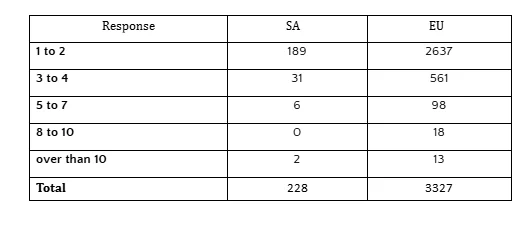
Question 47 "Do your own interests lie primarily in teaching or research?"
There exist a significant difference between the two countries in terms of interest shown by majority of the respondents interviewed. In Saudi Arabia, a lot of students and faculty members who teach various courses at the universities do not have interest in scientific research. For those who may develop interest are scared away by unfavourable factors such as low salary scale and challenges in funding major scientific research. This is quite opposite in EU countries where the state is committed in providing a suitable environment for scientific research. The government in EU countries offers a good salary scale to the group pursuing scientific research. Therefore, majority of the people find themselves developing interest in scientific research. The table below shows analysis of data drawn from various respondents.
Table 36: interests lie primarily in teaching or research
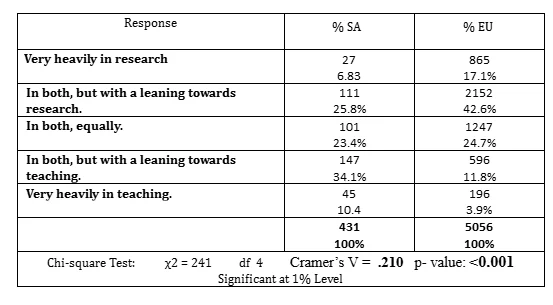
Table 36 shows that respondents in European Union group have more interest in research (59.6%) compared to Saudi Arabia group (32.63%), while more Saudi Arabia group interest in teaching (44.5%) compared to European Union group (15.7%). These differences are significantly different using chi square test (χ2(2)=241, p<0.001) at 95% significance level .This may be due to the fact that the environment is better suited for research in the EU countries, while in the Kingdom the researcher may face many difficulties, including bureaucracy, such as subject approval, budget. Moreover, having time to do the research.
Question 48 "Do your own responsibilities lie primarily in teaching or research?"
A lot of people teachers in Saudi Arabia often prefer to depend purely on teaching to than scientific research programs as a way of generating revenue. This is due to major challenges that are facing the field of scientific research. The issue of funding scientific projects is a major problem in the field of research, as such, a lot of teaching staff feel that engaging themselves into scientific research programs would subject them into future challenges. A number of scholars have acknowledged that funding of scientific research programs is a major problem faced by faculty members across all the institution of higher learning. In a recent study, the state agreed that as much as they have been putting a lot of effort to fund institutions of higher learning still much is needed in terms of research infrastructure and its connection to the society. According to the respondents, majority of the private and public sectors are reluctant to invest in scientific research due to the fact that they don’t have much faith in it. Additionally, low incentives and salaries is another reason for the weak scientific research. It has emerged that many faculty members who take their time carrying out extensive research have suffered low salary scale for a long time, this has scared away many potential researchers. The table below shows responses provided by different respondents in various field of study.
Table 37: responsibilities lie primarily in teaching or research

Table 37 provides information on participants’ responsibilities lie primarily in teaching or research? It can be seen that respondents in European Union group have more interest in research (38.8%) compared to Saudi Arabia group (14.8%), while more Saudi Arabia group have more interest in teaching (30.9%) compared to European Union group (66.4%). These differences are significantly different using chi square test (χ2(2)=278.44, p<0.001) at 95% significance level .
Q49: Do you consider any research you are doing to be in a (politically/ economically/ culturally/ ethically) controversial field?"
Table 38: doing research
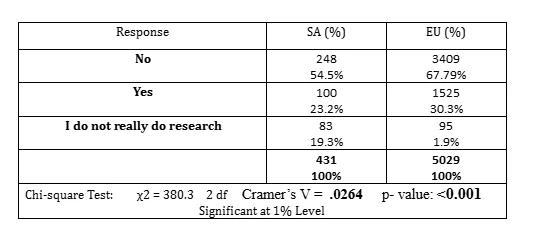
Table 38 shows that there is a high percentage of European Union group consider any research they are doing to be in a (politically/ economically/ culturally/ ethically) controversial field , which means that they are have more interest in research (67.79%) compared to Saudi Arabia group (54.5%). This difference is significantly different using chi square test (χ2(2)=380.3, p=0.0264) at 95% significance level .
Question 50 "In your current role, what do you feel are your two principal activities?"

Table 39.1 shows that there are (25.3%) regarding Administration/Management as one of two principal activities in the Saudi Arabia Sample group compared to (18.1%) in the European Union group with significant difference between both (χ2(1)=13.5, p<0.001) at 95% significance level .

It can be seen from table 39.2 that there are (86.1%) regarding Undergraduate Teaching as one of two principal activities in the Saudi Arabia Sample group compared to (51.7%) in the European Union group with significant difference between both (χ2(1)=189.6, p<0.001) at 95% significance level .

Table 39.3 shows that there are (10.7%) regarding Postgraduate Teaching as one of two principal activities in the Saudi Arabia Sample group compared to (24.3%) in the European Union group with significant difference between both (χ2(1)=11.4, p<0.001) at 95% significance level .

Table 39.4 reflects that there are (10.7%) regarding Postgraduate research supervision as one of two principal activities in the Saudi Arabia Sample group compared to (16.9%) in the European Union group with significant difference between both (χ2(1)=11.4, p<0.001) at 95% significance level .
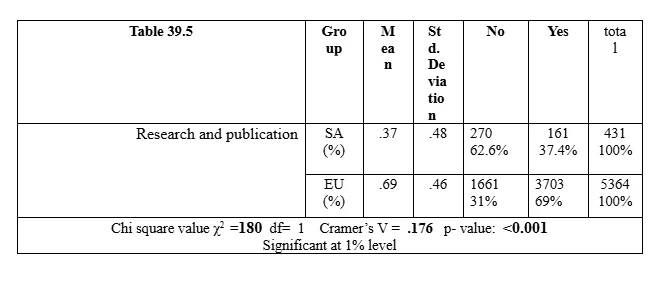
Finally table 39.5 shows that there are (37.4%) regarding research and publication as one of two principal activities in the Saudi Arabia Sample group compared to (69%) in the European Union group with significant difference between both (χ2(1)=180, p<0.001) at 95% significance level .
Question 51 “If you are currently supervising postgraduate students that are undertaking degrees by thesis, please specify the number of students you are supervising.”
The quality of education at Saudi has significantly risen over past few years. The government of Saudi continues to enhance quality education by providing quality training program to all students in the education sector. Such quality training ensure that there is an improving standards for evaluation of thesis students. Quality training has attracted a rising number of students taking degrees in post-graduate program, however, this number is relatively low as compared to that of EU where a lot of students opt to take their post graduate degree programs. The table below shows analysis of responses from different respondents when asked the number of post graduates they are currently supervising.
Table 40: number of students being supervised

Table 40 comparing number of students postgraduate students that are undertaking degrees by thesis supervised, it can be seen that less number from 1 to 10 are being supervised by Saudi Arabia group (97.53%) compared to European Union group (93.78%). On the other hand, more students are being supervised by European Union group (4.69%) compared to Saudi Arabia group (1.23%).
Question 52 "Are you currently engaged in any scholarly or research work that you expect to lead to the publication of monographs, journal articles, book chapters, etc.?"

In table 41 it can be seen that there are (35.5%) currently engaged in scholarly or research work that you expect to lead to the publication of monographs, journal articles, book chapters, etc. in the Saudi Arabia Sample group compared to (8%) in the European Union group with significant difference between both (χ2(1)=328.053, p<0.001) at 95% significance level .
Question 53 "Approximately, how many articles in academic journals or chapters in academic books have you ever had published?"
Saudi Arabia has currently become one of the most essential players in scientific study in the Middle East. This is enhanced by funding from the governmental departments that is committed to transform the nation from an oily based economy to a country of knowledge. Over the last few years, the kingdom has modernised its institutions of research thus creating top-tier universities. The country has also invested heavily in education scholarships in order to increase the number of experts in the field of science. Currently, the country has managed to attract skilled personnel across the globe to its institutions. Saudi researchers have also involved themselves in collaborations with other global peers, as a result, there has been a significant increase in the number of published articles in academic journals. The table below shows the analysis of data from different respondents in two different countries when asked the number of articles in academic journals they have ever published.
Table 42: many articles in academic journals or chapters in academic books have you ever had published

Table 42 shows distribution of number of articles in academic journals or chapters in academic books than have ever been published is absolutely inversed for European Union and Saudi Arabia groups. As the percentage is at its highest for no articles published for Saudi Arabia group (29.53), then it begins to decline for more and more published articles to reach only (4.47%) for more than 30 articles published. On the other hand, it is the opposite for European Union group as it is at its lowest for no articles published (3.13%) gradually to reach its highest for more than 30 articles published (45.01%).
Question 54 "How many books of an academic nature have you ever had published (including those that you have edited, coedited, coauthored)?"
Table 43: Numbers of books of an academic nature have you ever had published

Regarding number of books of an academic nature have ever been published (including those that you have edited, coedited, coauthored), table 43 the majority of Saudi Arabia group published 1 to 10 books (96.27%) compared to less percentage for European Union (90.99%). Whereas, European group respondents tend to publish more books 11 to 20 (6.98%) compared to (3.73%) for Saudi Arabia group.
Question 55 "During the last five years, from where have you funded your research?"
A lot of private and public institutions tends to make their grants to non-profit enterprises. Persons seeking grants often follow a different path rather than charities of the public. Individuals seeking funds needs to be both flexible and creative while seeking funds to finance their research. People who are affiliated to university should always contact their department office. Many universities often have an office established for the sponsored programs that assist in coordination of grants request. It also assist researchers in getting grant opportunities. Some universities have local chapters that assist in running the funding research. Another approach that some institution use to fund their research programs is by finding non-profit fiscal sponsors who offer full support to the research. During the research, respondents gave their views on ways they got their funding to particular research programs.
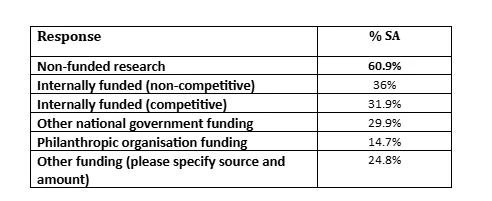
This question invited those respondents to provide more information about other funding source and amount)
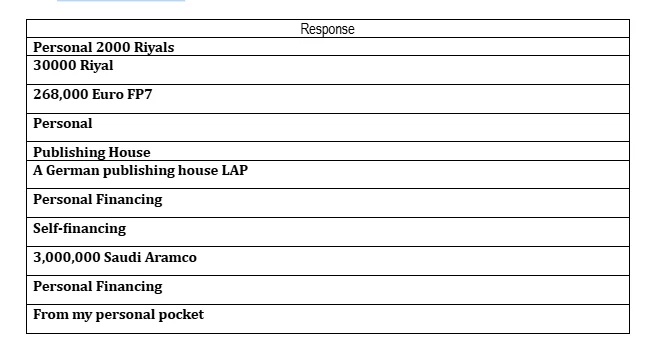
Question 56 "To what extent have you been engaged in each of the following types of research over the last five years?"
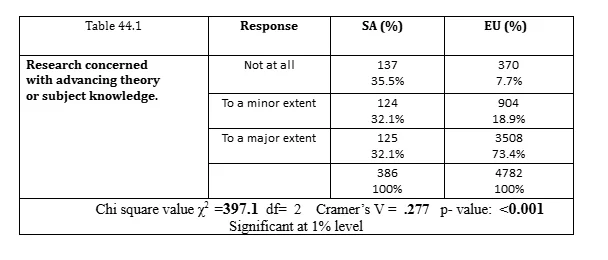
Table 44.1 shows respondents answers to what extent they have been engaged in Research concerned with advancing theory or subject knowledge over the last five years, Saudi Arabia group have equivalent distribution for all responses; not at all (35.5%), to a minor extent (32.1%) and to a major extent (32.1%). On the other hand, more respondents in the European Union group are engaged in this type of Research to a major extent (73.4%), with less as minor extent and least as not at all. These differences are significantly different using chi square test (χ2(2)=397.1, p<0.001) at 95% significance level.

Regarding to what extent they have been engaged in Research directed to informing your teaching over the last five years, table 44.2 shows that Saudi Arabia group have a directional distribution; not at all (70.4%), to a minor extent (18.4%) and to a major extent (11.2%). On the other hand, most of respondents in the European Union group are engaged in this type of Research to a minor extent (47.9%), followed by not at all (35.3%). These differences are significantly different using chi square test (χ2 (2) =189.4, p<0.001) at 95% significance level.

Policy oriented research
Policy oriented research contains different goals and orientation as compared to both disciplinary and policy analysis research. Policy-oriented research is a practical research that focuses on providing information concerning policy making. Analysis of policy is systematic process of evaluating different policy options or choices. The policy analyst uses the results from policy oriented research in assessment of the policies instead of conducting a practical research. Policy oriented research is targeting human societies aspects aimed by the government. The table below shows the outcome of respondents when asked whether they have engaged in a policy oriented type of research.

Table 44.3 shows staff responses when have been asked to what extent they have been engaged in Policy-oriented research, to inform public or voluntary bodies over the last five years, Saudi Arabia group have a directional distribution; not at all (73%), to a minor extent (16.9%) and to a major extent (10.1%). On the other hand, most of respondents in the European Union group are not at all engaged in this type of Research (52.6%), or with only a minor extent (30.9%). These differences are significantly different using chi square test (χ2(2)=59.4, p<0.001) at 95% significance level

Table 44.4 reflects respondents answerers when they have been asked to what extent they have been engaged in Research concerned with advancing theory or subject knowledge over the last five years, Saudi Arabia group have equivalent distribution for all responses; not at all (35.5%), to a minor extent (32.1%) and to a major extent (32.1%). On the other hand, more respondents in the European Union group are engaged in Research to a major extent (73.4%), with less as minor extent and least as not at all.These differences are significantly different using chi square test (χ2(2)=14.5, p<0.001) at 95% significance level.
Q-57 If you have any other comments / opinions you would like to add about academic freedom in relation to academic work and responsibilities, please type them in the comment box below

Conclusion
This chapter outlined the study results as presented by the statistical findings of the extent academic freedom of faculties in Saudi Arabia. The research results sought to answer the general research question of the extent of academic freedom in Saudi Arabia. The results showed that a significant number of the faculty members who responded to the study’s survey had no idea of the existence of a policy guiding document regarding academic freedom in their work places, while a few faculty members were aware of the existence of a policy document on institutional academic freedom. Additionally, most of the respondents were ignorant as to whether the institution policy document provided for the protection of academic freedom. Other sections that showed limited knowledge and awareness included the handling of staff complaints and grievances regarding the violations of academic freedom in academic institutions; others noted that they had no idea as to whether there is a change towards the protection of academic freedom in academic freedom within the recent years; other respondents also outlined their ignorance of whether their employment contract can be terminated based on the lack of academic freedom. The results also showed the respondents had high positive views and perceptions regarding the level of protection for academic freedom within their academic institution. With regard to personal experiences of the members of the academic institutions/faculty, there was no influence regarding the extent of knowledge about academic freedom and the protection of its related policy documents. In addition, there is a slight increase in the protection of academic freedom within the faculty over the years. Nonetheless, a significant number of the study’s respondent were of the view that the protection of academic freedom was deteriorating as years go by.
A few of the study’s respondents have faced disciplinary actions within their institutions because of expressing their academic views in teaching, research publications and in non-public forums within and outside their institution. Further, a number of the respondents indicated in the results that they had been subjected to/threatened with denial of their promotion because of their academic views, while others had been subjected to/threatened with demotion to a lower position because of their academic views. Moreover, other respondents noted that they had been moved to another department/center/unit because their academic views and other members of the faculty had been subjected to/threatened with being given different/fewer/additional administrative tasks, teaching or research duties or removal of research funding/facilities/equipment because of their academic views. Others have been bullied by their fellow academic colleagues because of their academic views. The results have further shown that a moderate number of the respondents had experienced restrictions of their right to travel; others had faced legal actions; others have been refused publication of an article/book/book chapter or participation in a conference by their institution because of their academic views. Also some respondents have been refused publication by the state authorities because of their academic views. An insignificant number of the respondents indicated that they had been subjected to/threatened with sexual harassment by an individual within the academic faculty. Moreover, an average number of the respondents indicated that they had experienced false charges that were brought against them by a fellow worker within their academic institution. The results also indicated that a moderate number of the respondents had practiced self-censorship. However, only a few of the respondents reported that they had experienced or had been threatened with, infringement of their academic freedom by a fellow employee within their academic institution due to their race, membership of an ethic minority, gender and political views.
- 24/7 Customer Support
- 100% Customer Satisfaction
- No Privacy Violation
- Quick Services
- Subject Experts



